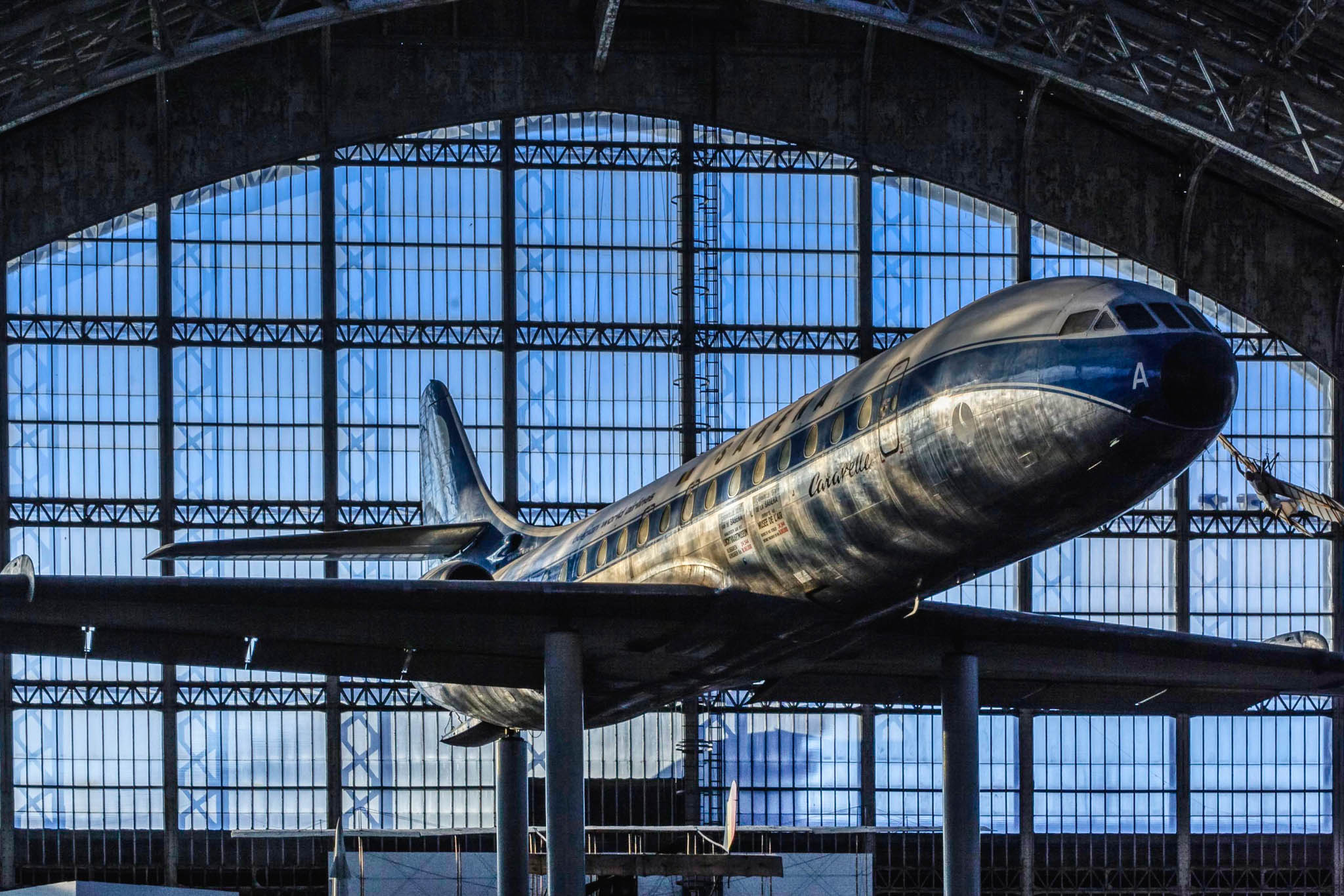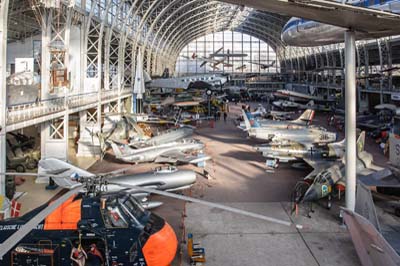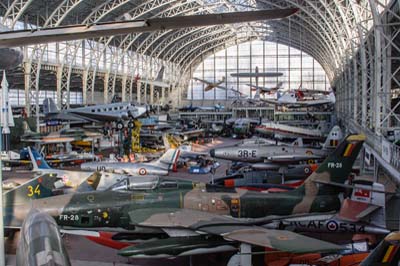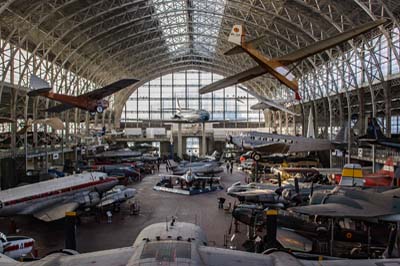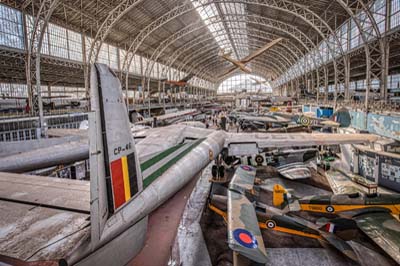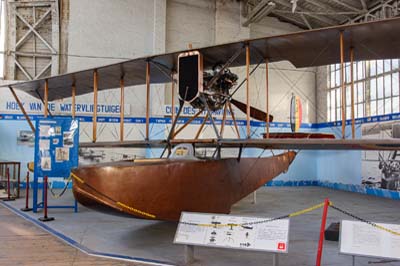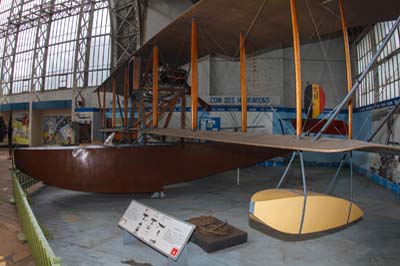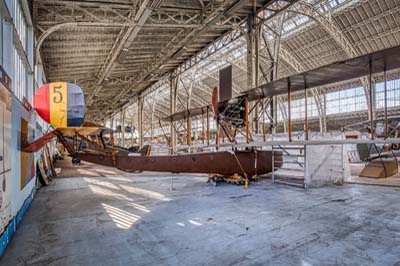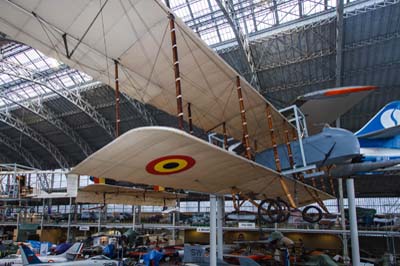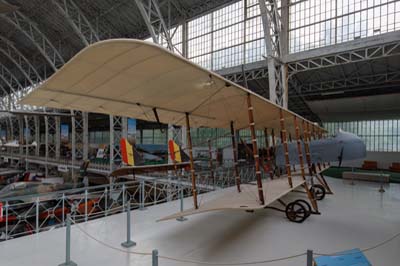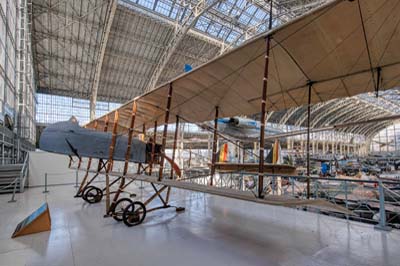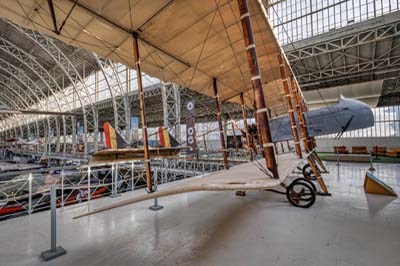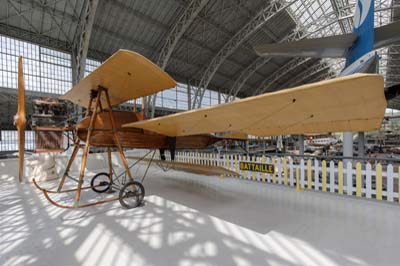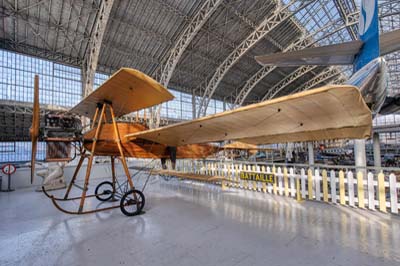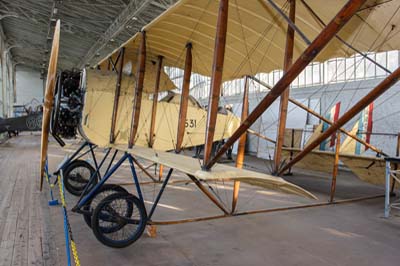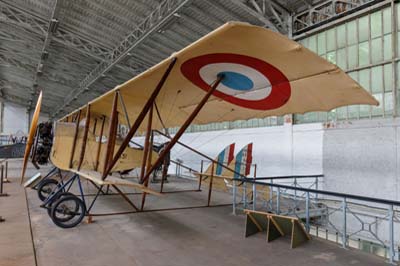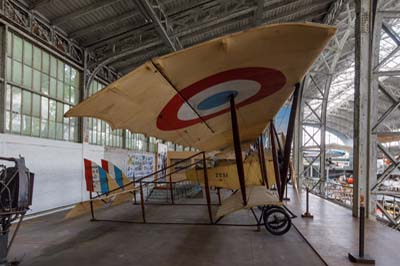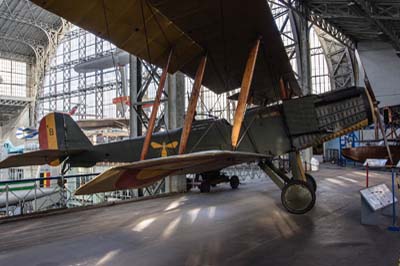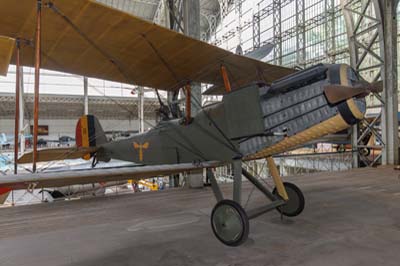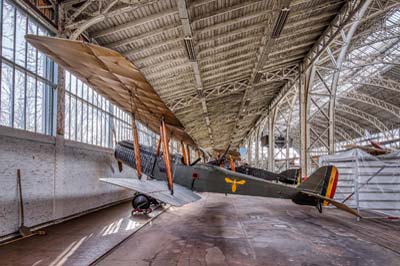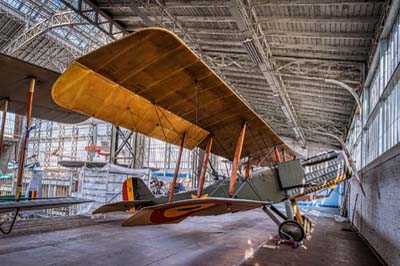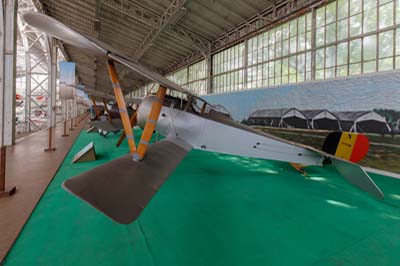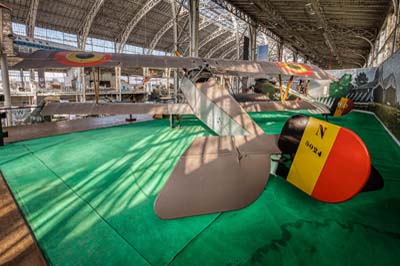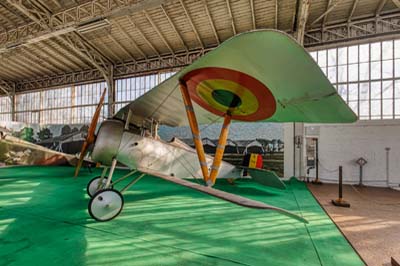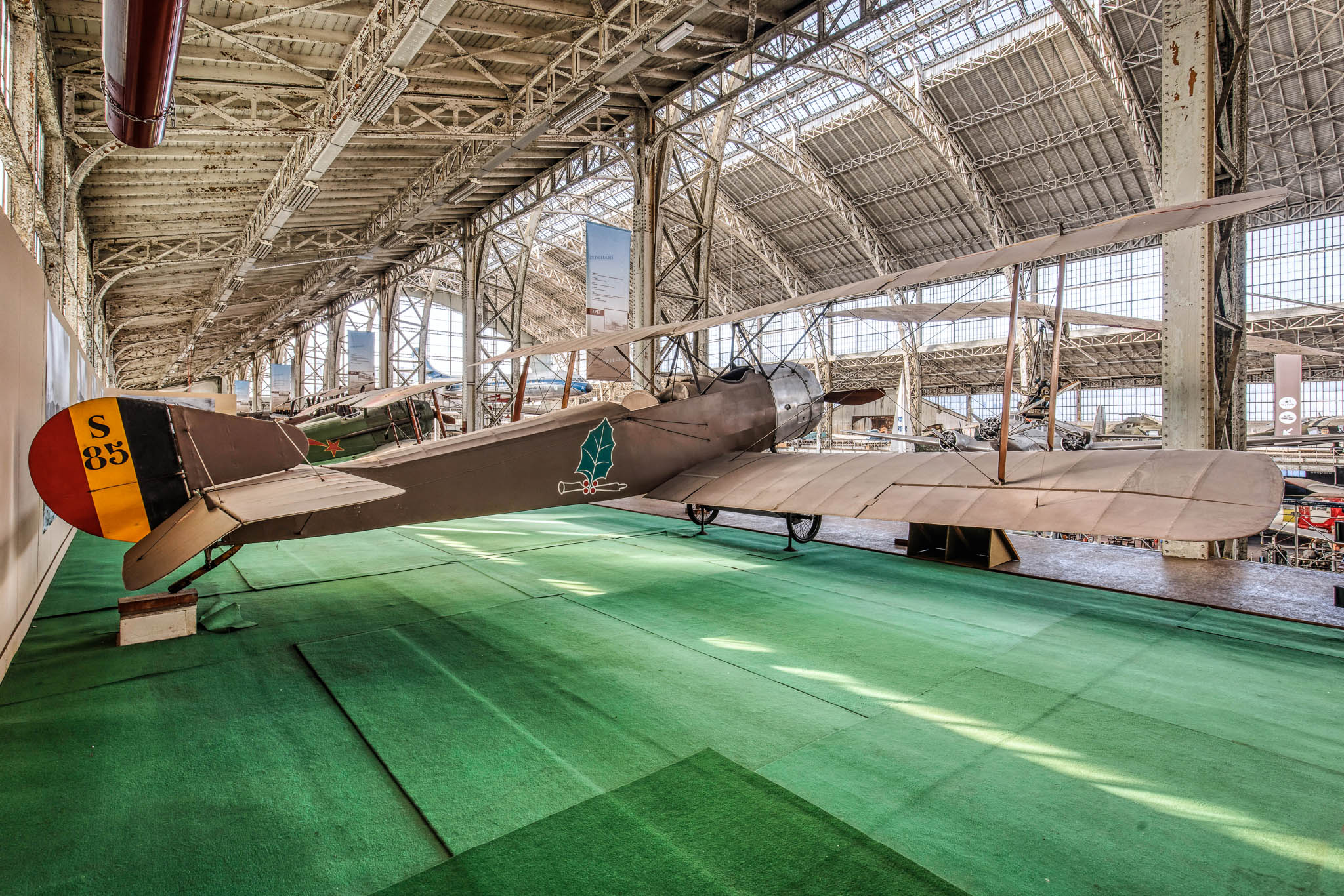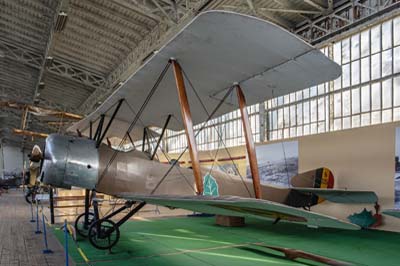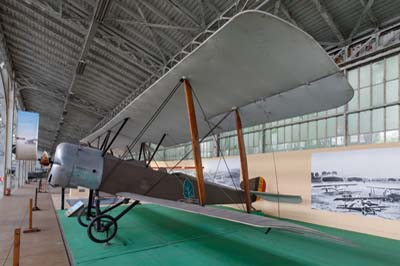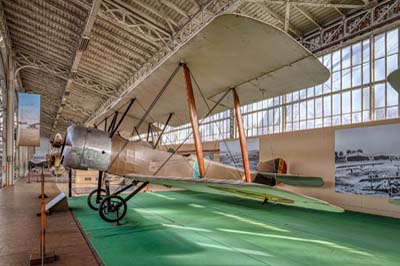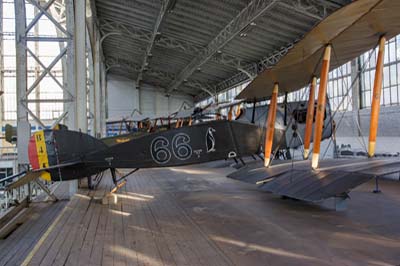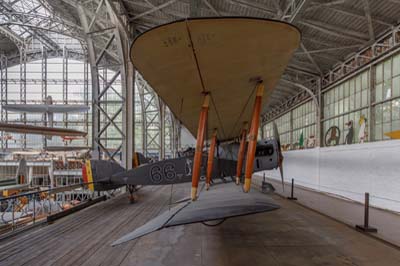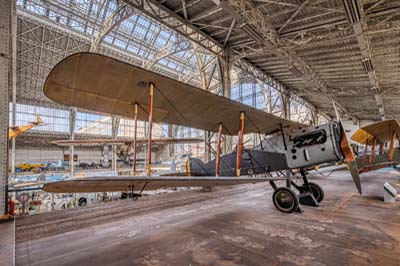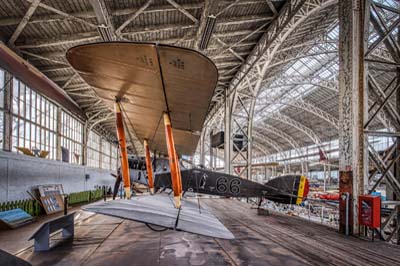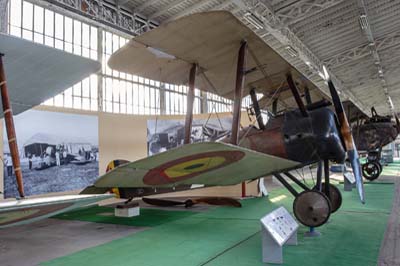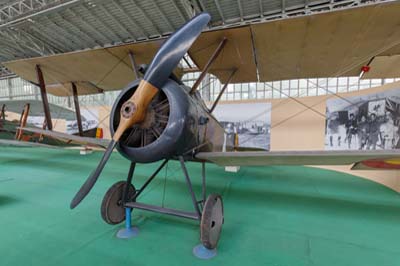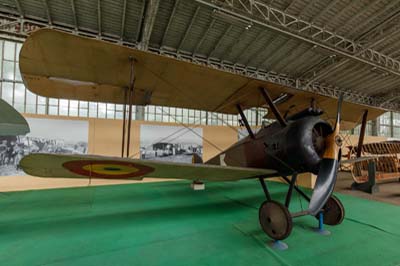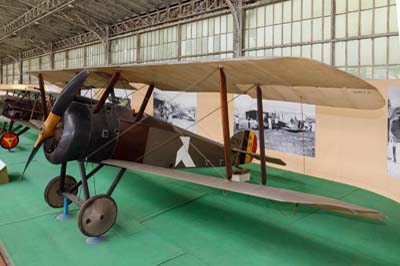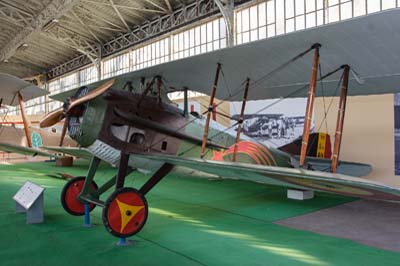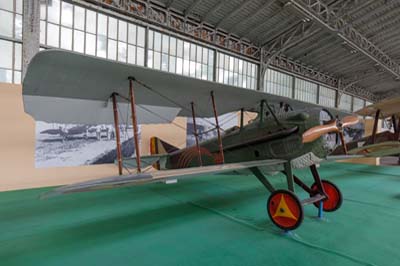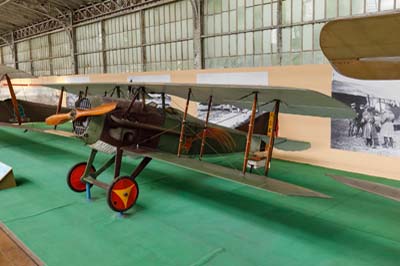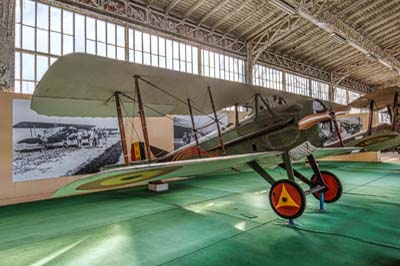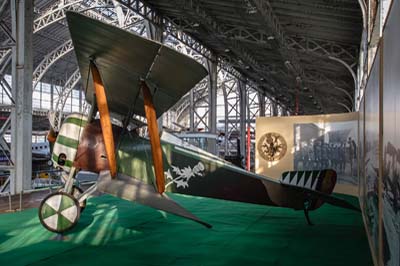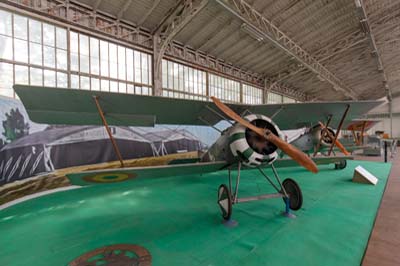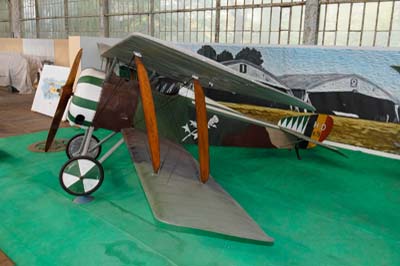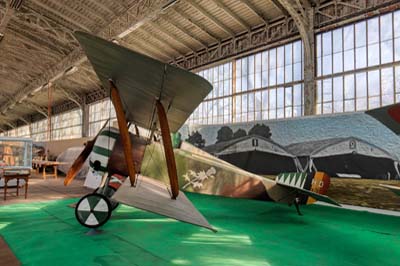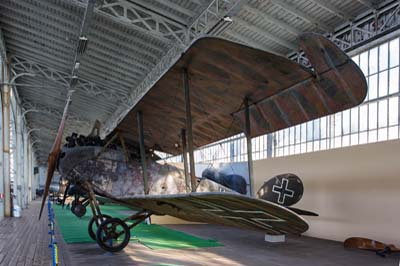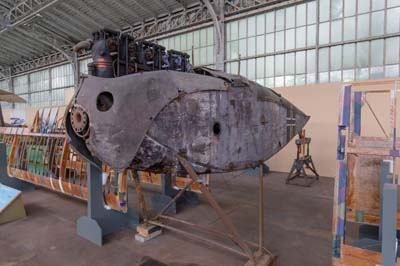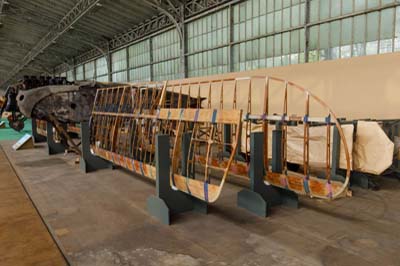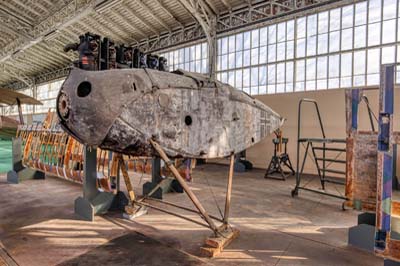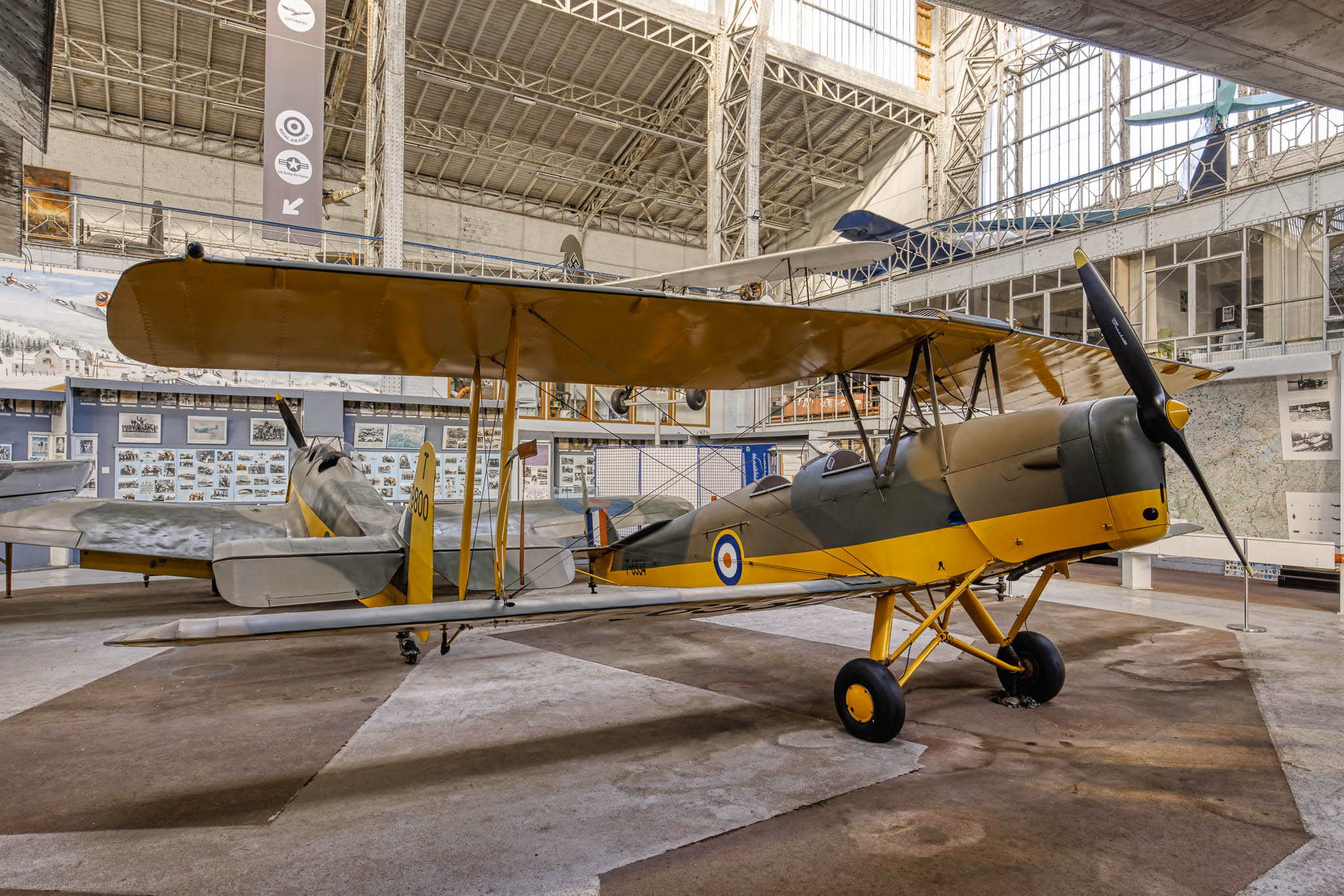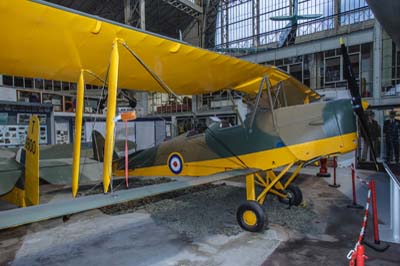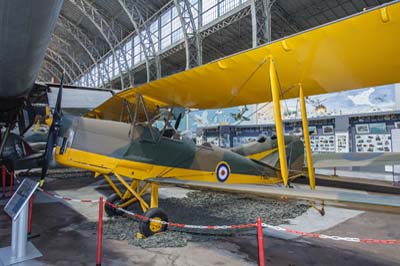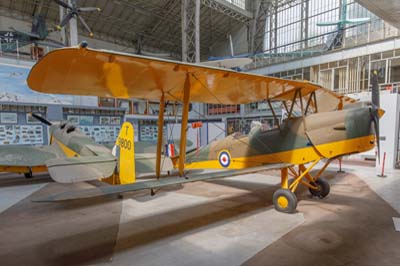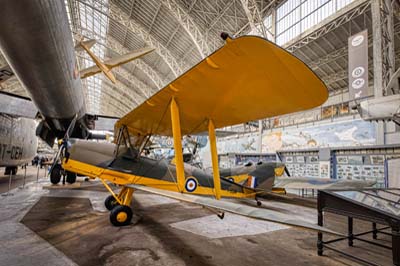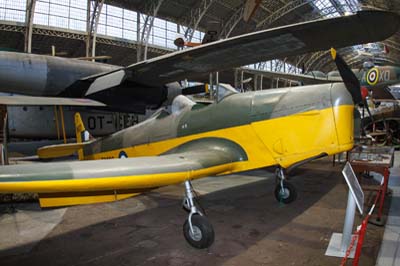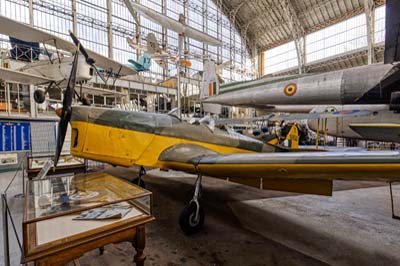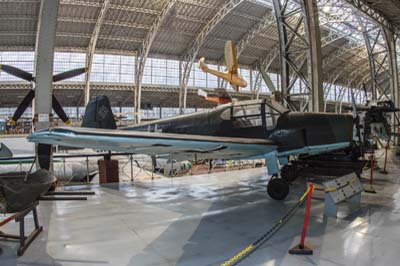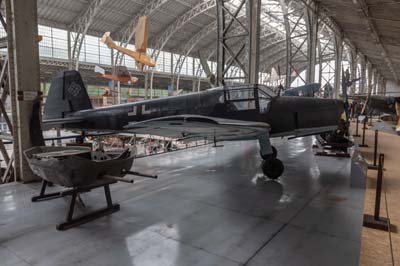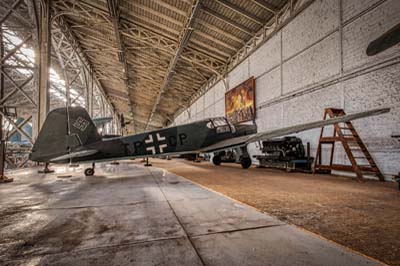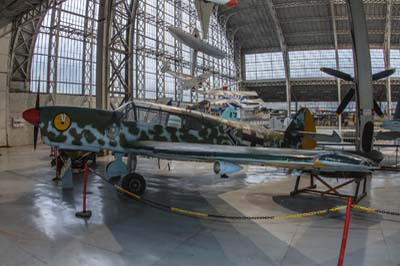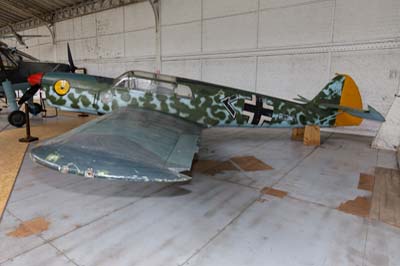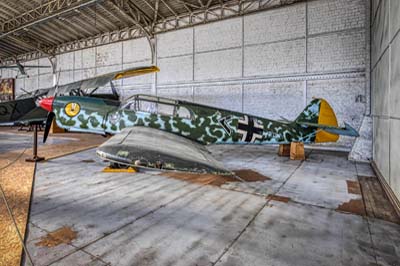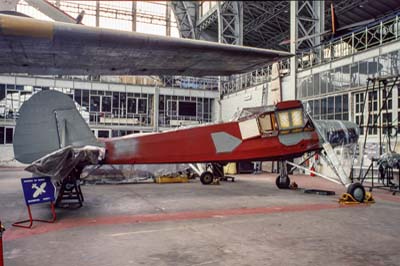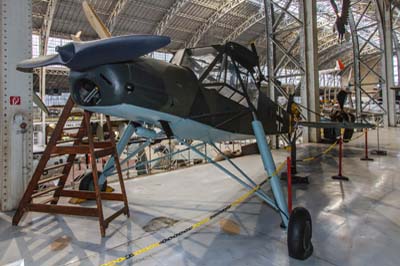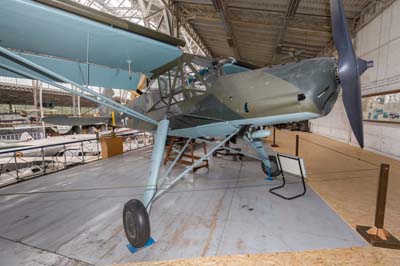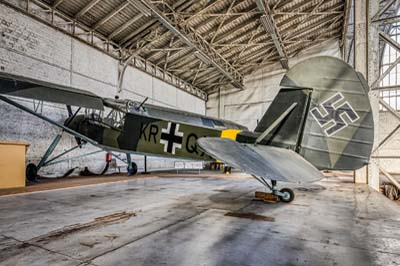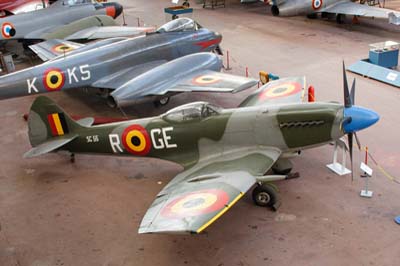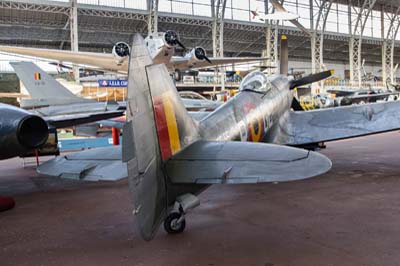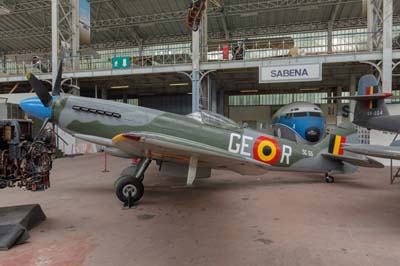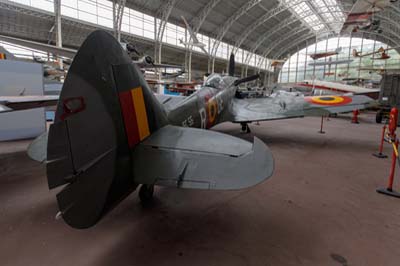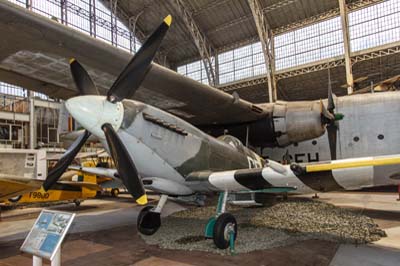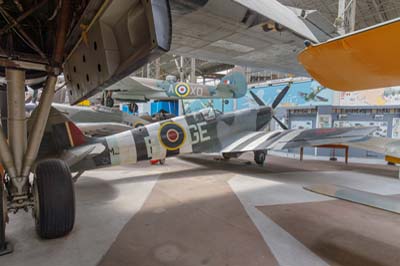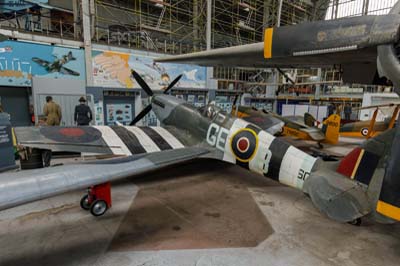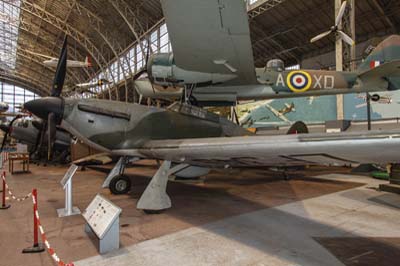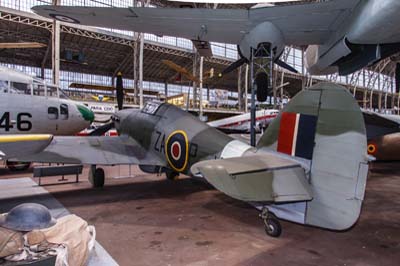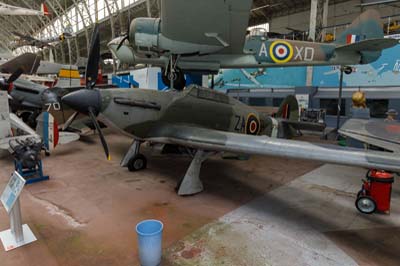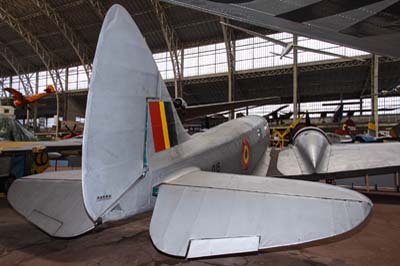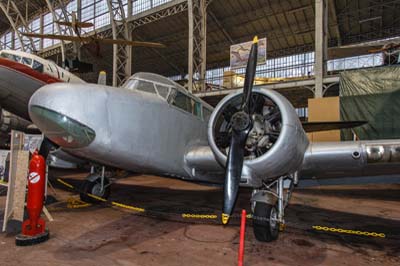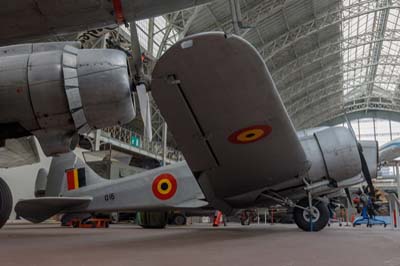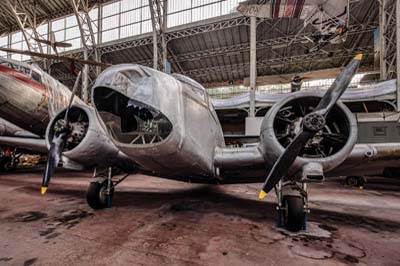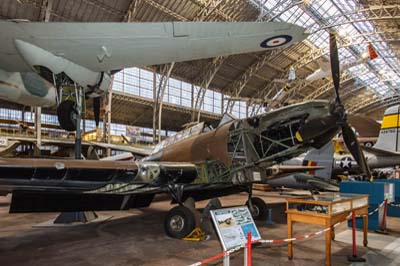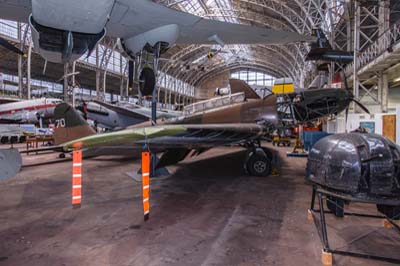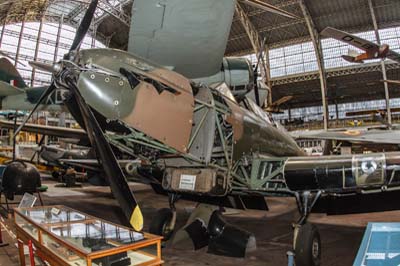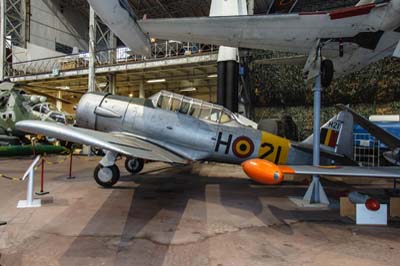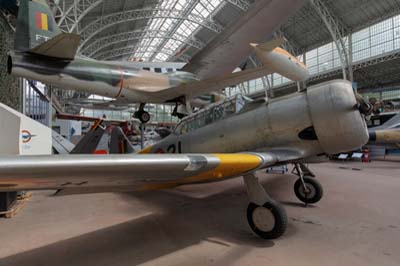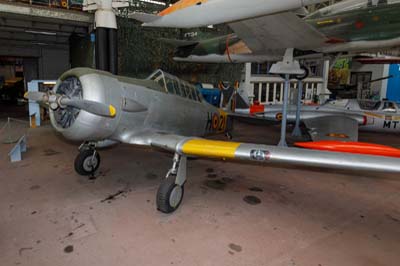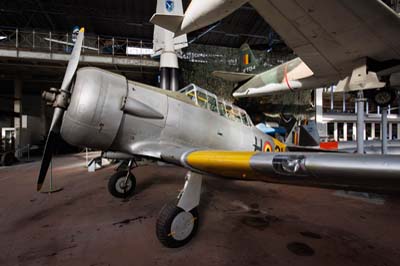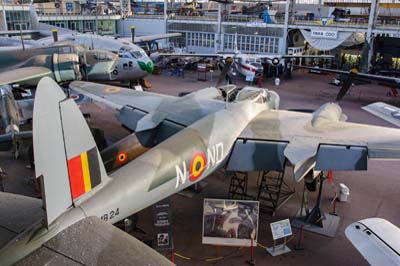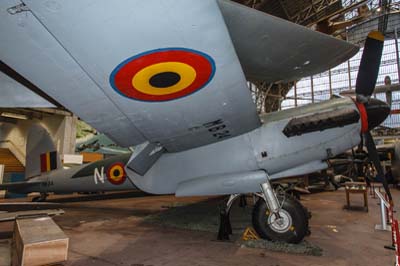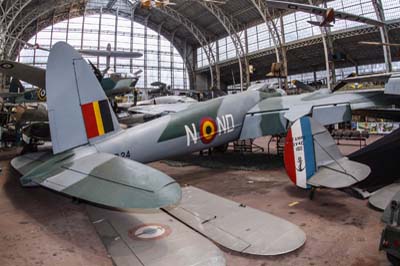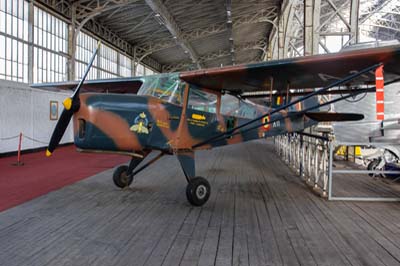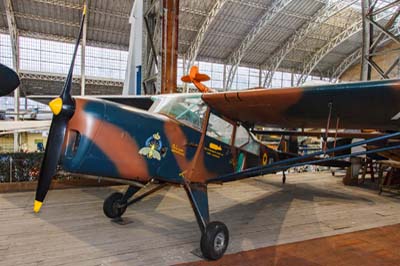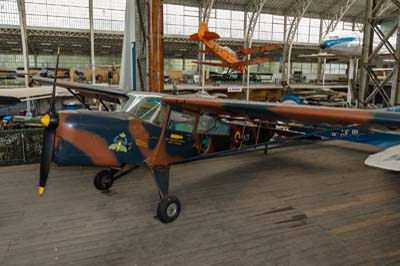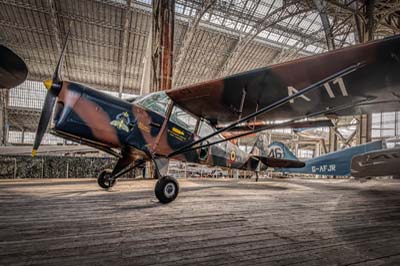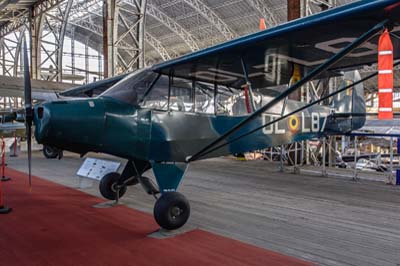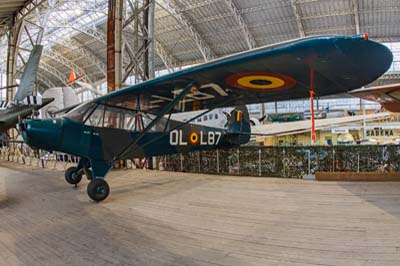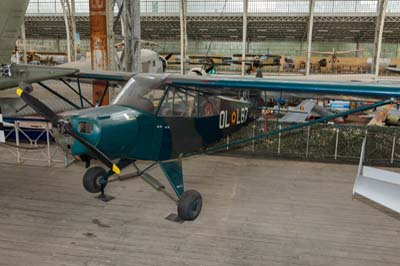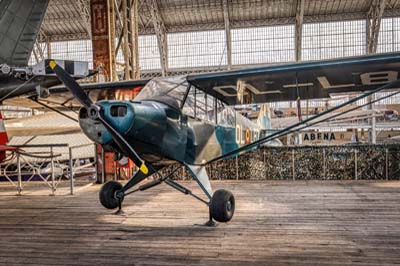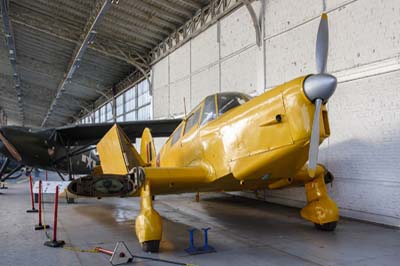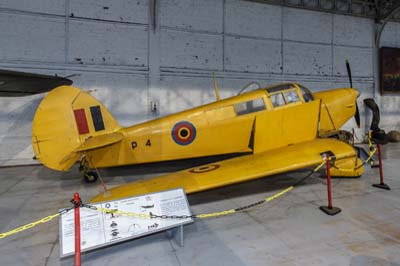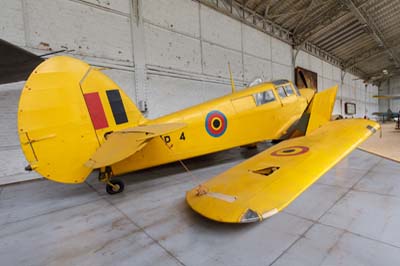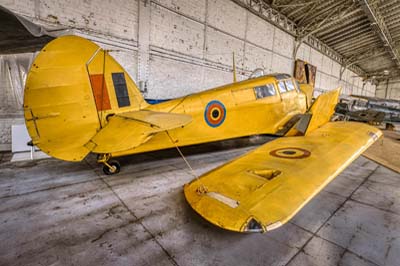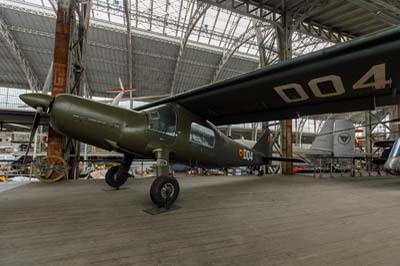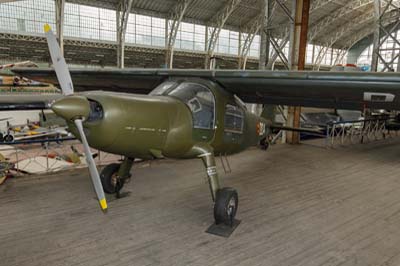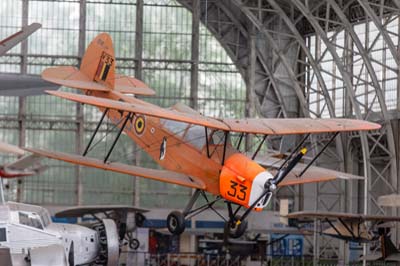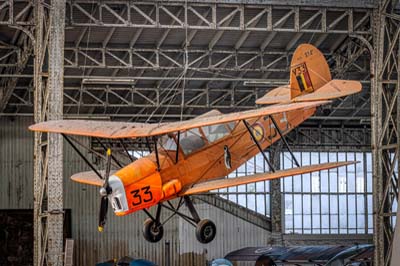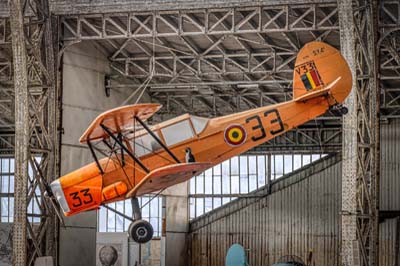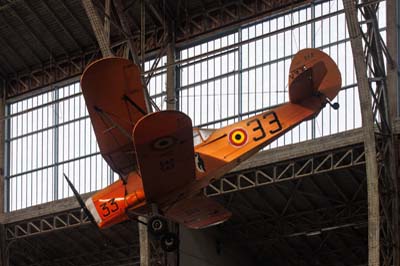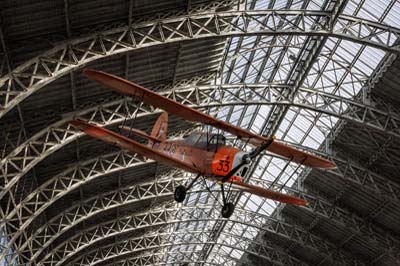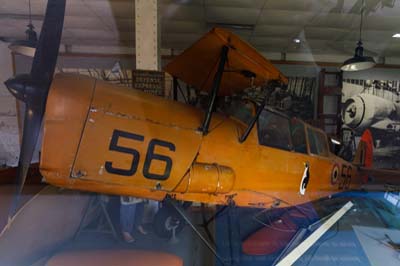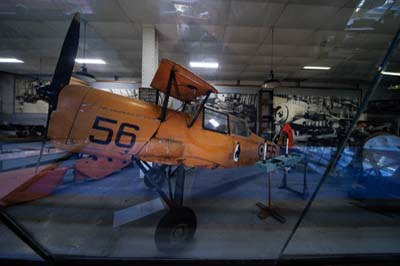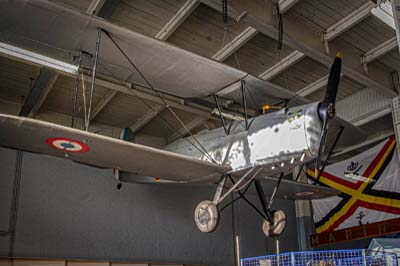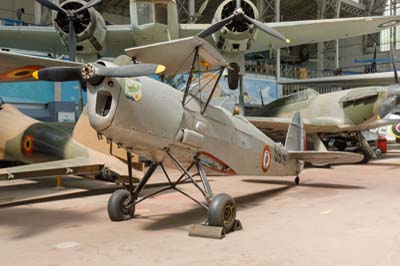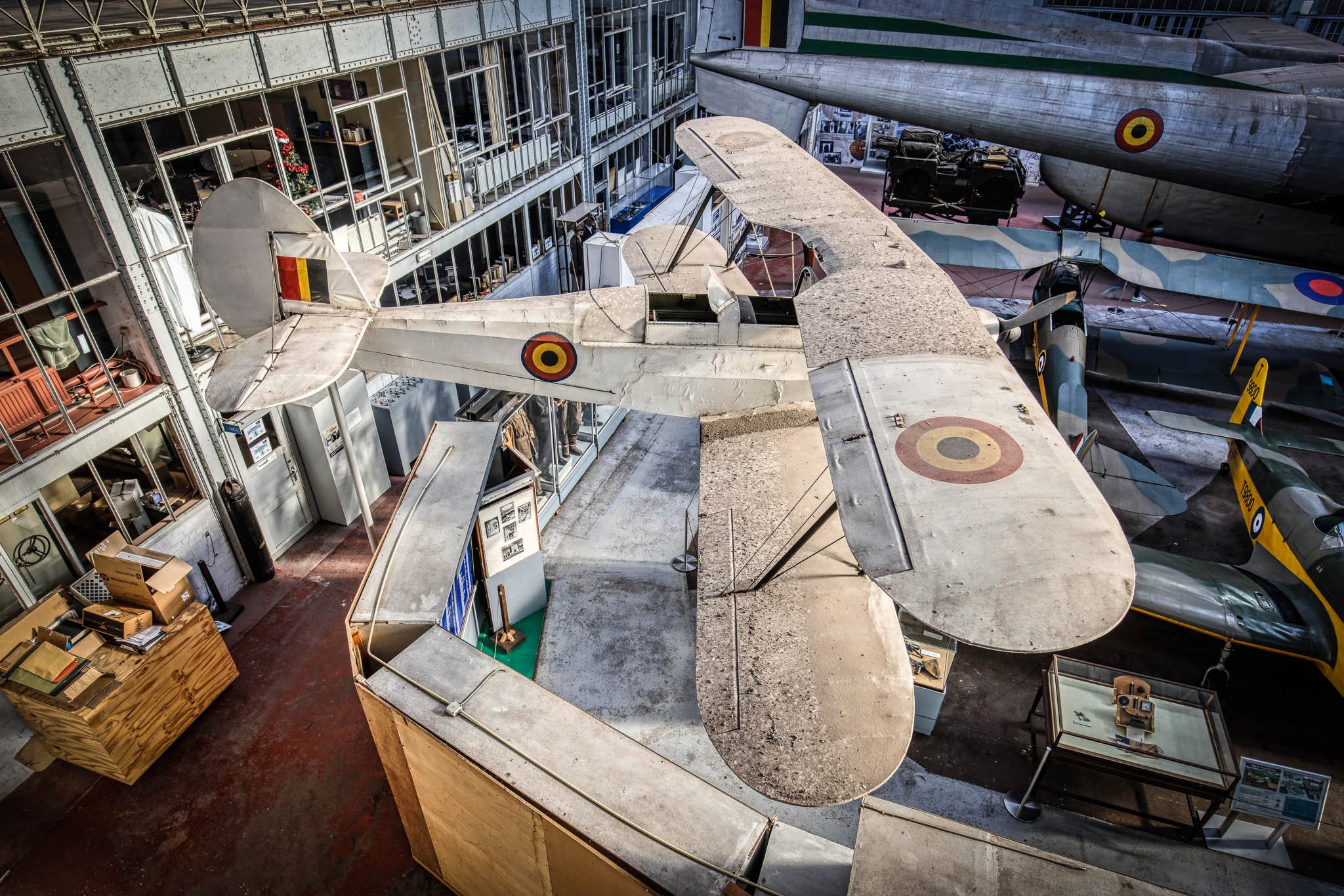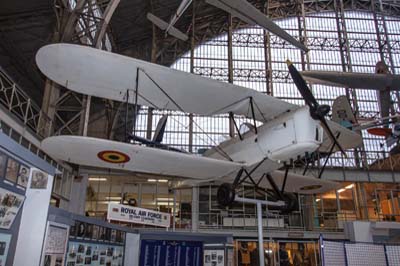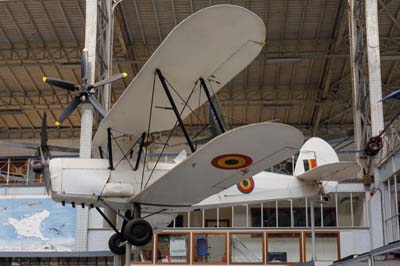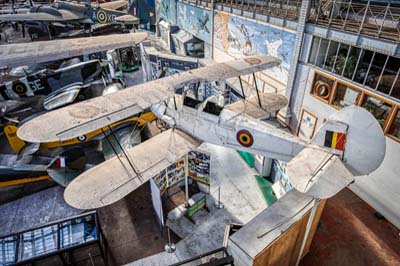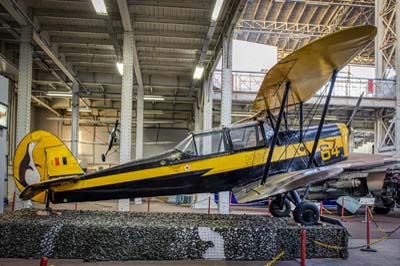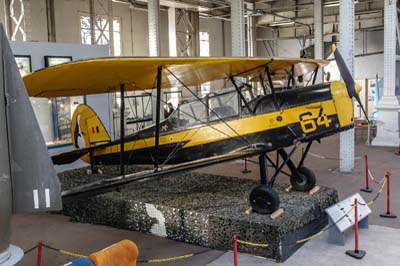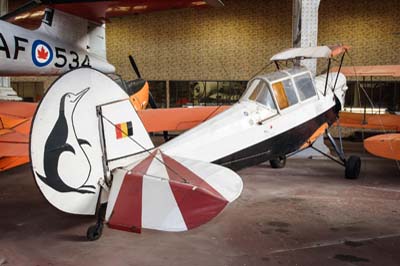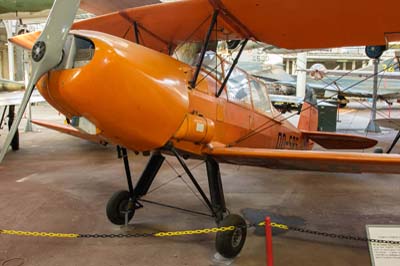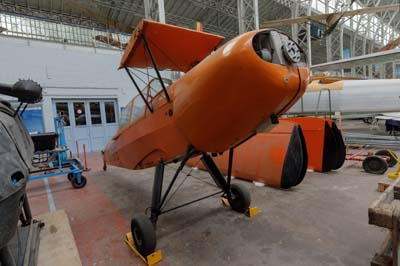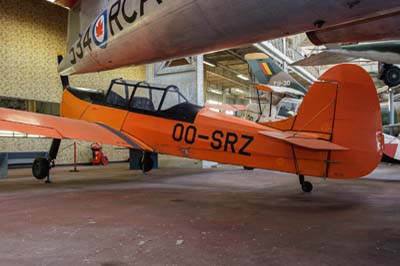Royal Museum of the Armed Forces and of Military History
(Air and Space Department)
(Musée Royal de l'Armée et d'Histoire Militaire, Bruxelles)
Brussels
2005, 2009, 2018, 2019, 2022 and 2024 |
| The Brussels Air Museum is located within the 'Musée Royal de l'Armée et d'Histoire Militaire', which looks more like a palace than a series of exhibition halls. This very impressive collection of aircraft and is made even more pleasing to the eye of the aviation photographer by the grandiose surroundings in which they are displayed. |
Former SABENA Aérospatiale SE210 Caravelle 6N (OO-SRA),
illuminated by the low winter light shining through the spectacular south facing window. |
A Brief History of the Museum
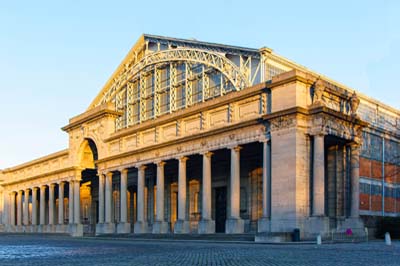 |
The 'Musée Royal de l'Armée et d'Histoire Militaire' from the front in 2005, showing the vast aviation hall rising above the grand museum entrance. |
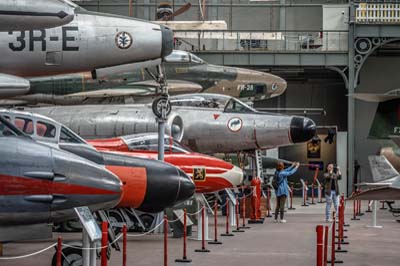 |
Some of the 1950s jets are stacked to save space. |
The exhibition halls were designed in 1875 to celebrate the Belgium's 50th anniversary. Construction continued for the 1910 in Jubilee Park (Jubelpark) and the Jubilee Palaces, as they became known, were used for successive equestrian events and exhibitions, including the World Exhibition in 1910. By 1923 the buildings moved over to its current role, as Belgium's main military museum. In 1972 a dedicated Air and Space department was formed, followed by an Armoured Vehicles section in 1980 and a Naval section in 1996.
The impressive Great Hall, which is built of stone, iron glass and part tin roof, is 560 feet (170m) long, 230 feet (70m) wide and 130 feet (40m) high. Around the entire hall is a balcony accessed by four sets of stairs located at each corner. Every inch of available space is used to display the aircraft, including the entire balcony area. Some aircraft hang from the roof whilst the biggest exhibit, a former SABENA Caravelle airliner is on three metal stilts. Similar metal supports are used to lift aircraft above those at floor level, thereby enabling considerably more aircraft to be exhibited. I first visited the museum in 1976. In those days the museum consisted of over 70 identifiable aircraft, 42 of which were still on display in 2005, many were still roughly in the same places even. By December 2005 I noted that the aircraft on display had grown to almost 100. |
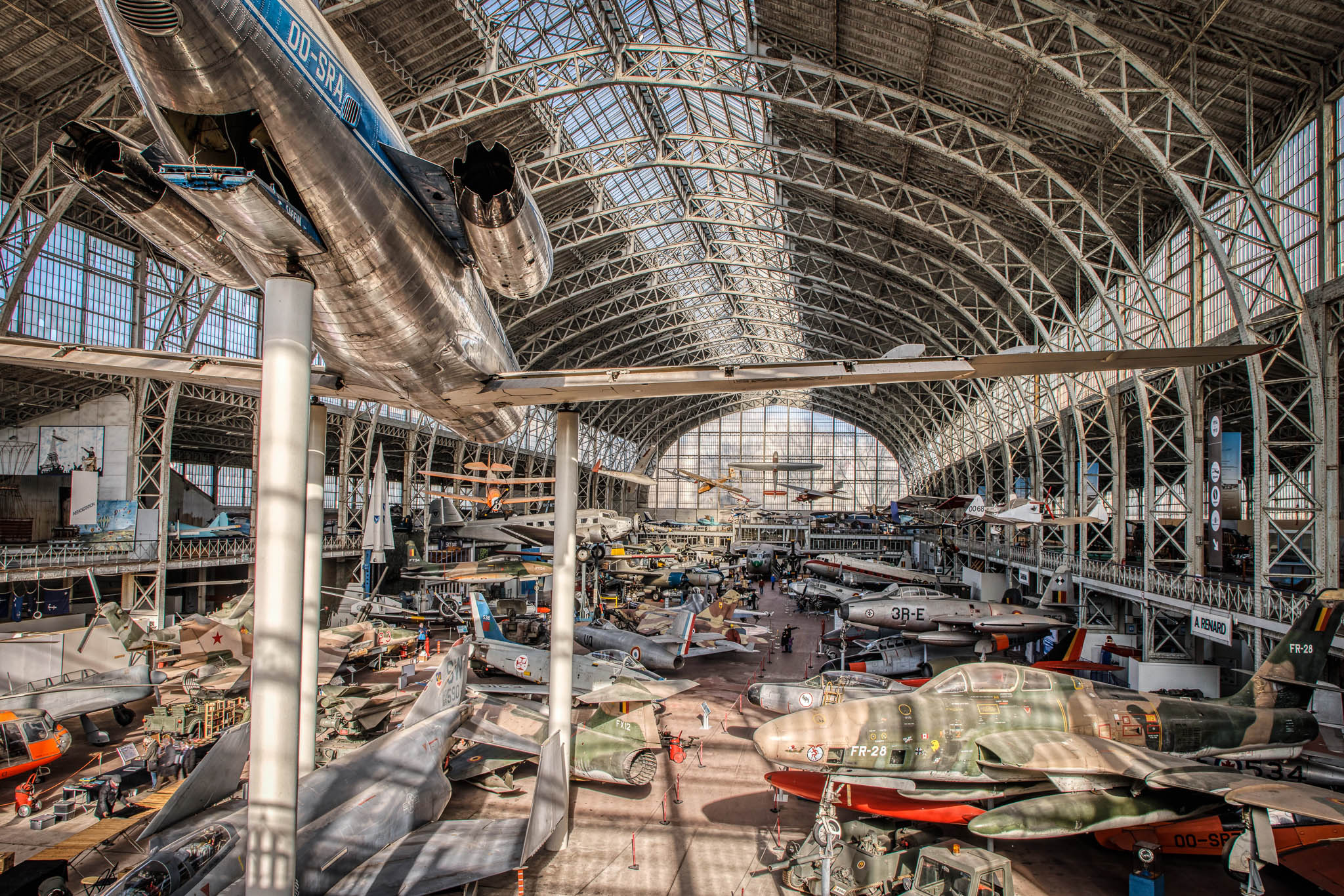 |
| Views of the aviation hall taken mezzanine. The first two images are from the front (south western end) of the museum, the other two from the rear of the hall looking over the C-119G Flying Boxcar. |
Building up a collection, by trading and swapping
So what has happened to the collection in the intervening 30 years, particularly with regard to some missing exhibits? In the early years the collection comprised mostly of aircraft with a Belgian connection, there were also many duplicate types. Later a policy evolved where duplicates were traded or swapped (e.g. Royal Danish AF Chipmunk for an Stampe-Vertongen SV.4C (V-62) for aircraft from all over the world. Some aircraft were commendably returned to flying status e.g. a DH.82 Tiger Moth (OO-SOE) and Lysander (OO-SOT) and sold on. The Ju 52 and F-86F came from Portugal.
Today they have many Eastern European aircraft, including; an L-29R Delfin (in 2005, gone by 2009), a LET C.11 (Yak-11) and a MiG-15bis (in 2005, gone by 2009)from the Czech Air Force, an Auster AOP.6 (OO-FDI / A-16) went in the opposite direction to the museum at Kbely in the 1992. There is also a MiG-23BN 'Flogger' formally of the Egyptian Air Force, a Mil Mi-24D 'Hind' from the former East German Air Force (NVA) and a MiG-21F 'Fishbed' of the Indonesian Air Force (on display in 1995 and gone by 2009).
Other Western aircraft added to the collection in recent years have included; a F-86F Sabre from the Portuguese Air Force, an ex USAF RF-4C Phantom, a former West German Air Force G-91 and also a J35A Draken of the Royal Swedish Air Force. Where the Museum was unable to get original examples of former Belgian Air Force serving aircraft, they have been acquiring alternative examples, such as; a Caudron G.III, DHC.1 Chipmunk, CF-100 Canuck, Meteor NF.11, F-86F Sabre and DH.89 Dragon Rapide (Dominie).
In November 2007 Avro 652A Anson C.19 (G-AYWA formally OO-CFA, OO-DFA and OO-VIT) arrived by road at Beauvechain and later was transferred to the museum's storage facility at Vissenaken for restoration, it formally served with Sabena. In February 2008 a for Belgian Army Alouette II was exchanged for a British Sycamore HR.14, this type having operated in the Belgium Congo with the Belgian Air Force and so is a valuable addition to the museum. In July 2008 Dassault Mirage 5BA (BA-03), the former Temploux airfield gate guardian was exchanged with the Polish Aviation Museum ('Muzeum Lotnictwa Polskiego') at Krakow for a Mil Mi-2 helicopter. |
The Belgian Air Force, a brief history
Belgium is a country divided into two languages, Flemish/French, consequently names can be presented in two ways. Naturally I am mostly using the English versions, but have added the Flemish and French versions in brackets. The Belgian Air Force (Belgische Luchtmacht/Force Aérienne Belge) was founded in 1909, as a branch of the Belgian Army with balloons. By 1913 the aircraft became part of a separate section. In 1915 the Aviation Militaire was formed, this was renamed Aeronautique Militaire in 1925. After World War Two there needed to be extensive rebuilding of Belgium's military forces. On October 1, 1946 the Belgian Air Force (Belgische Luchtmacht/Force Aérienne Belge) was formed, using Belgian wartime squadron numbers from the Royal Air Force. On January 2, 2002 each branch of the Belgian Armed Forces were combined under a single command. The Belgian Air Force became the Air Component (Luchtcomposant/Composant Aérienne).
The Aircraft on Display |
| Aircraft from World War One |
| Schreck FBA Type H (5.160). Designed by Louis Schreck in Argenteuil, France from 1913. Production was halted from 1918 to 1920 and later the Franco-British Aviation (FBA) Company went in to Liquidation in 1934. These FBA seaplanes were used for maritime patrol. Five Schreck FBA.H versions were issued to the "Escadrille des Hydroaviations" of the Belgian Air Force, founded in 1917 and based in Calais. They assisted the French Navy in searching for submarines and floating mines, till the end of the War. |
| Farman MF-11A2 'Shorthorn' (unmarked) It was designed by Maurice and Henri Farman at the Farman Aviation Works in France as a light bomber it went into service in 1914 and was withdrawn from the Western Front in 1915. The Farman brothers designed and built over 200 types of aircraft between 1908 and 1941. |
| Farman MF-XI dating from 1914. |
Caudron G.III (C.2531). The Caudron G.III was designed by Gaston and Rene Caudron was built from May 1914. Around 36 G.III served with the Belgian Air Force from 1918. They were finally retired from Belgian military service in 1928. The example on display (No.2531) was received from the Paris Air Museum following an exchange.
|
| Royal Aircraft Factory RE.8 (8) is one of only two in existence the other (F3556) is in the Imperial War Museum at Duxford. Built by the Royal Aircraft Factory in England, the Reconnaissance Experimental 8 (R.E.8) was a successor to the R.E.7 and entered service in 1916. Initially used for reconnaissance, it was later employed for ground attack missions. Despite being very vulnerable to enemy attack, due to its poor manoeuvrability and an initial tendency to spin, over 4,000 were built. 22 R.E.8s served with the Belgian Air Force. All examples were quickly withdrawn from service after the War. |
| Nieuport 23C-1 (N5024) it equipped all french squadrons by 1916. Acquired in the 1920's it was restored and put on display in 2006. It is the only surviving Nieuport 23. |
| Sopwith 1½ Strutter (S-85). It was the first allied fighter aircraft to be equipped with a synchronised machine gun, mounted above the engine and designed to fire between the propeller blades. It was designed and built by Sopwith Aviation Company in Kingston on Thames, England, it's first flight being in 1916. Called the 1½ Strutter, because the upper and lower wings on each side of the aircraft were connected by a pair of full struts near the wing tip with a pair of half struts connected the upper wing to the fuselage. 27 of the 6000 built were sold to Belgium, by 1920 but in the same year the Sopwith Company was wound up and the 1½ Strutter was declared obsolete by the military. The example on display is painted the colours of the 3rd Reconnaissance Squadron (3éme Escadrille d'Observation) of the Belgian Air Force. |
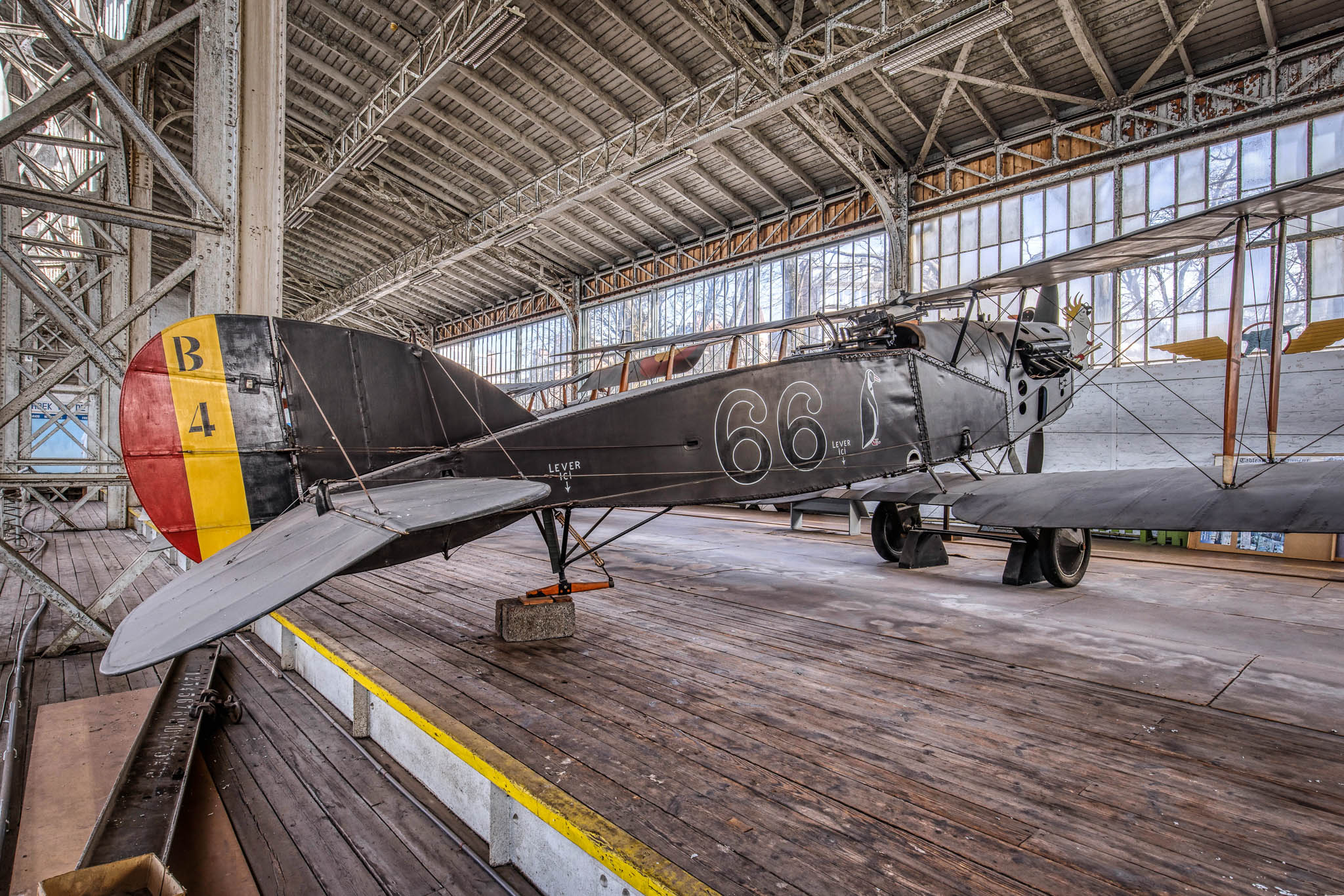 |
| Bristol F.2B (BAPC19 marked 'B4/'66'). Built by the Bristol Aeroplane Company, the prototype F.2A made its first flight in September 1916. After some modifications the F.2B went into production. Eventually 5,329 examples were delivered, some serving until 1932. Belgium received some 16 F.2Bs along with a number of other countries. SABCA (Societe Anonyme Belge de Constructions Aeronautiques) in Belgium built another 40 F.2B mark IVs. The example exhibited was constructed from various parts at Weston-On-The-Green and acquired for the Museum in exchange for a Spitfire IX (MK912) in 1989. |
 |
| Sopwith F.1 Camel (SC-11 previously RAF B5747). Developed from the Sopwith Pup, it was the most successful aircraft of World War One. It's name was derived from a slight hump forward of the cockpit. 5,490 were produced from 1916 and they claimed more kills (1,294) of German aircraft than any other allied fighter. Eleven companies apart from Sopwith Aviation Company built the Camel, including Fairey Aviation. It was found to be a difficult aircraft to fly due to its rotary engine that generated torque, which unless full right rudder was used on take off, caused inexperienced pilots to ground loop. During World War One, 413 Sopwith Camel pilots died in action with 385 pilots being killed through accidents. 58 Sopwith Camels served with the Belgian Air Force (serials SK- and SC-) from March 1918 until 1922. |
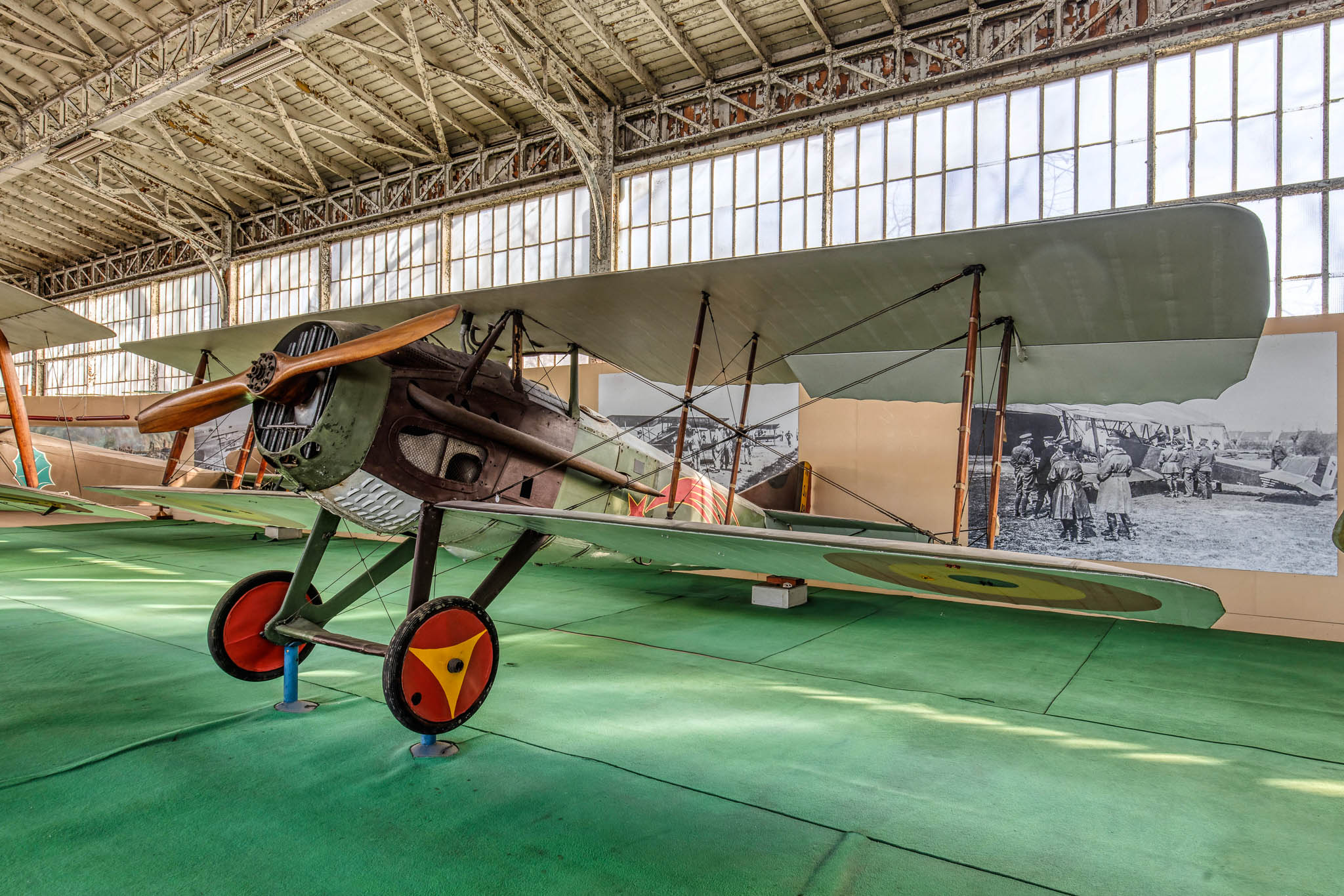 |
| Blériot SPAD XIII C.1 (SP-49) in the markings of 10 Squadron. The red comet markings with five pointed star and tail was first used in 1917 by 5 Squadron (Smaldeel/Escadrille) before it was re-designated 10 Squadron. The red comet was later adopted by 2 Wing. The aircraft were originally built by 'Societie des Productions Armand Deperdussin' (SPAD) in France. Later the company was then taken over by Louis Blériot in 1913, when it was renamed 'Societe Pour l'Aviation et ses Derives' (also SPAD). The SPAD V first flew in 1915 and was the prototype for the SPAD VII, which entered service one year later. The larger and improved SPAD XIII followed, first entering service in September 1917, with double the fire power of the SPAD VII. The SPAD quickly became a much sort after aircraft. Eight factories in France (including Blériot), two in England and one in Russia built this rugged fighter. The Belgian Air Force introduced the SPAD S.VII C1 (serials SP-1 to SP-22) and later the SPAD XIII in March 1918. At least 37 SPAD XIIIs were allocated to 10 Squadron (10me Escadrille de Chasse). SP-49 arrived at the museum in 1920. |
| Hanriot HD.1 (HD-78). The Hanriot-Dupont HD.1 was designed by Pierre Dupont and built at the Hanriot factory at Billancourt in France in 1916. At least 79 HD.1s were delivered to Belgium from 1917 (serials HD-1 to HD-79). The example on display (HD-78) is the actual aircraft flown by Belgian's highest scoring fighter pilot, Baron Willy Coppens de Houthulst during World War One, when with 9 Squadron (9me Escadrille). The Baron, who trained to fly at Hendon, England in 1914, is credited with 37 victories 34 of which were observation balloons. In the course of claiming his 37th victory in October 1918 and another balloon, he was hit in the leg and crashed. Unfortunately his leg had to be amputated, it was just a month before the war ended. After the war he served military attaché to France and was the first person to congratulate Charles Lindberg after his historic flight. He was also military attaché to Britain, Italy and Switzerland before retiring in 1940. He died in 1986 at the grand old age of 94. (HD-75 is on display at the RAF Museum at Hendon). |
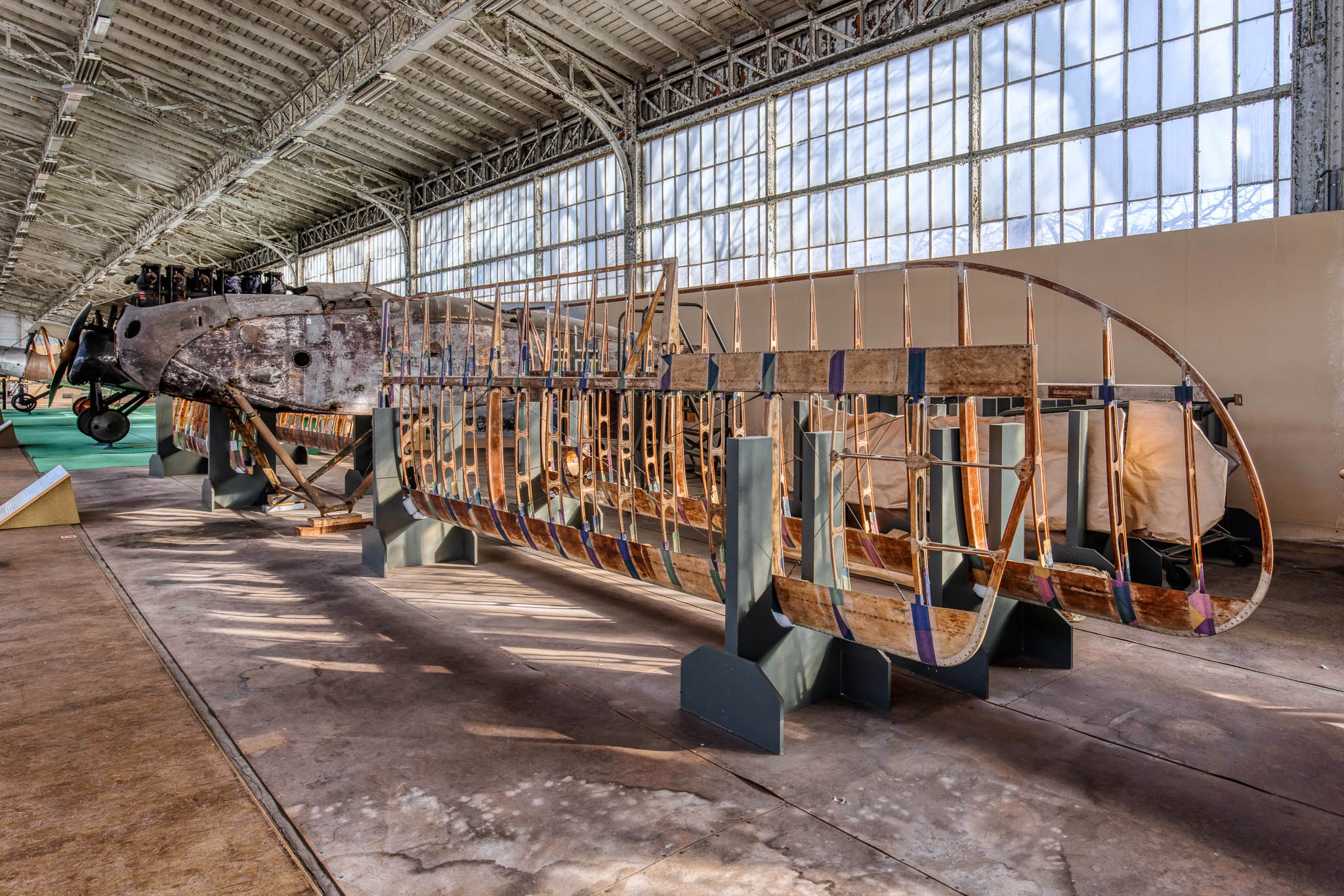 |
| Halberstadt C.V (3471/18 marked '3470/18') is the only Halberstadt C V still in existence. The first German biplane fighter to enter air combat was built by Halberstadt. The example exhibited was built in 1918 and arrived at the museum in 1920, unrestored it is still in it's original markings. It is now currently being restored. |
| de Havilland DH.82A Tiger Moth (OO-EVT c/n 84875). This former Centre National de Vol à Voile (CNVV) Tiger Moth returned to the Museum in December 2005 for display. It had been previously been on display at the Sabena Old Timers Association. It is now been restored in its original Royal Air Force colours as T6534. |
| Miles Magister 1 (T9800 later G-1 and OO-NIC) It was delivered to the Saffrenberg Technical School for ground instruction in 1946. This restored aircraft is thought to be a composite, it was found at Ghent airfield (now closed) where it had been derelict for some years. It is one of just 13 former RAF Magisters that survive today. As photographed when registered; OO-NIC at Ghent in 1973. |
Bücker Bü181B Bestmann (TP+CP Luftwaffe c/n 021969, later OO-SNE ntu and OO-RVD) .The prototype made its first flight in 1939 andt was later used by the Luftwaffe as a primary trainer. The Bücker factory at Rangsdorf built most of the Bu181, supplemented by the Fokker factory which built 708 aircraft of which 373 were delivered to Germany from 1942 to 1943. Hägglund and Söner AB in Sweden built 125 Bu181's for the Swedish Air Force as the Sk.25. The Zlin plant in Czechoslovakia built 783 aircraft as the C.6 and C.106 for the Czech' Air Force and also the Zlin Z.281 and Z.381 which were for civilian use.
The example on display joined the Belgian register as OO-RVD in 1949 and was then based at Grimbergen. It ended its flying days at Ostend where it was found in a derelict state before it passed to the museum. |
| Nord N.1002 Pingouin (F-BERF ex 184 AdlA, painted in false Luftwaffe colours). This is a French built version of the Messerschmitt Bf.108 Taifun. From 1942 production of the Bf.108 moved to SNCAN Société Nationale de Constructions Aéronautiques du Nord) at Les Mureaux in France, where before the end of the war, 170 Bf.108's had been built. From the end of the war production continued as the Nord 1000 (with a German Argus engine), 1001 Pingouin I and later the 1002 Pingouin II which both had Renault engines. Eventually 286 were built by SNCAN for the AdlA to be used as communications aircraft. Later when they were retired they were sold on for civilian use. |
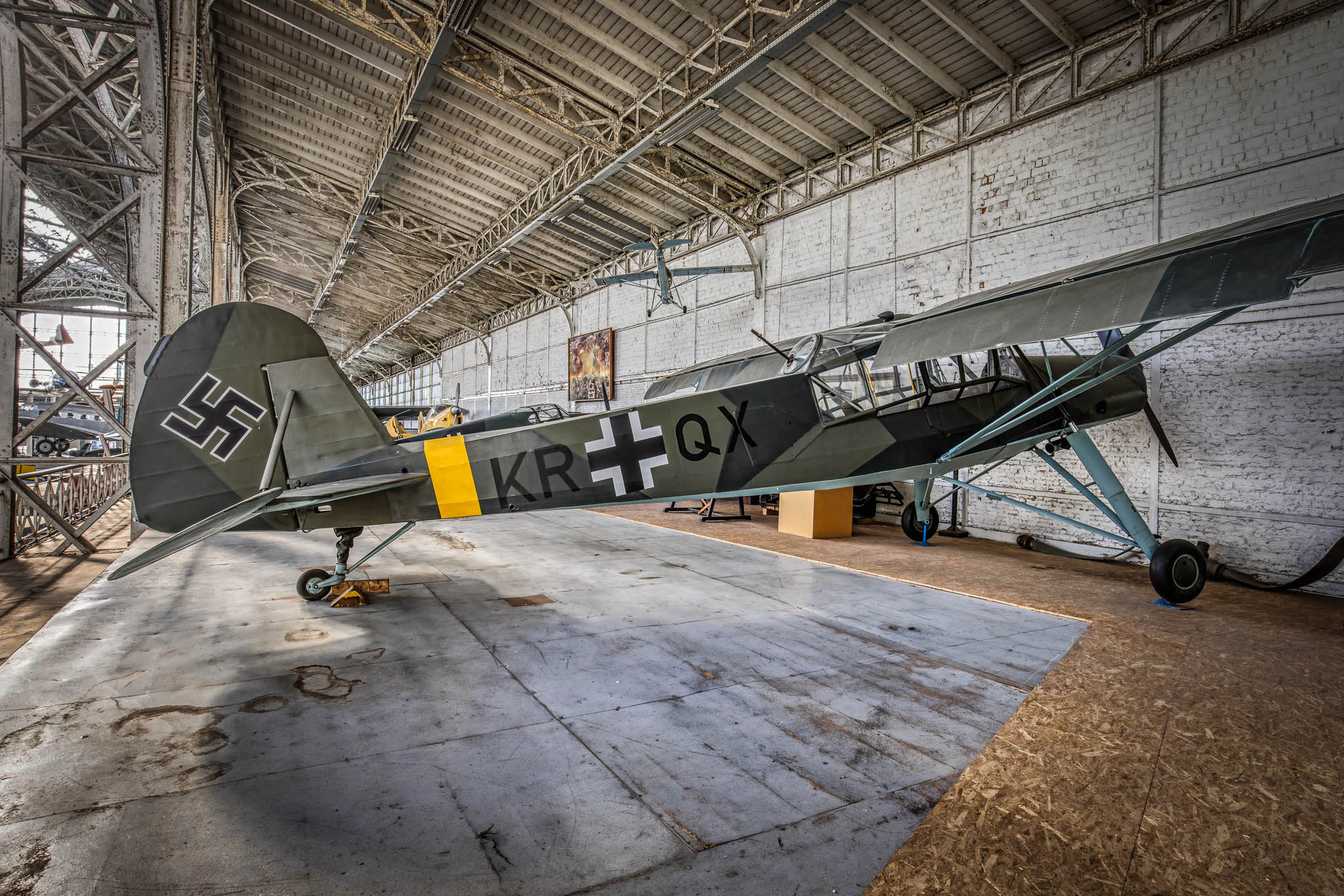 |
Fieseler Fi 156C-3 Storch 'Stork' (5503 KR+QX later Fv3822 SwAF and then OE-ADT). The Storch was designed in 1935 and widely used by German military forces throughout the war. More than 2,900 were put into service between 1939 and 1945 as light transports and as air ambulances. During the way the Fi-156 was produced in Germany an in occupied countries. It was built at the MRAZ factory, in Czechoslovakia and in France by Morane-Saulnier at Puteaux. Post war two versions were built in France, the MS.500 with the Argus in-line and the MS.502 with a Salmson radial. It is highly maneuverable with an extremely low stalling speed. It can take off in less than 200 feet at just 25 mph.
The Fi 156 on display was originally built in 1941 at Kessel with Werke Number 5503. Just before the end of the war it landed at Äkesholm, Sweden with two others after they got lost in fog. It later served with the Swedish Air Force from 1948 as the S-14b with serial Fv-3822. |
| Rebuilding an Air Force after World War Two. |
| Supermarine Spitfire FR.14e (SG55 'GE-R' formally MV246). This Spitfire originated from the Aldermaston factory in 1944, but went into store with 9MU at RAF Cosford. In 1948 it was sold to the Belgian Air Force, moving to 348 Squadron of 1 Wing at Bevekom/Beauvechain as SG-55 and coded 'GE-R'. A landing accident in 1948 ended it's flying days after only 23 hours. It later moved to Evere and was passed to the Museum of the Army. The restoration of SG-55 and using parts from SG-37 and SG-46 which collided in 1949, was started in 1977 and finally completed in 1997. Between 1946 and 1954, 43 LF.9s and 135 FR.14s were sold or loaned to Belgium (serials SM-1 to SM-43 and SG-1 to SG-132). Click here for a more detailed history. |
| Supermarine Spitfire LF.9c (SM15 painted as 'MJ360 GE-B' really ex MJ783 RAF). |
Hawker Hurricane Mk.IIc (LF658 marked 'LF345 ZA-P'). It was designed in 1934 and entered service in 1937 as the fastest fighter in service by 100 mph. By 1939 500 were in service with eventually 32 squadrons being equipped with them. Hurricanes shot down more enemy aircraft during the Battle of Britain than all the other air and ground defences combined. They later were used in North Africa and in the Far East against Japan. At the end of the war they were deemed obsolete, replaced by the more effective Tempest and Typhoons.
Four Hurricanes were passed to the 367 Squadron Belgian Air Force in 1946, the first of which was the original LF345 'ZA-P' the last of which was LF658. As photographed in 1982. |
 |
Airspeed AS.10 Oxford 1 (O-16 ex MP455) of 21 Squadron Belgian Air Force. Following the end of the World War Two, 42 Oxfords (serials O-1 to O-42) were transferred to Belgium for use as communications aircraft with 367 Squadron. They remained in service until their retirement in 1954.
The nose was badly damaged in 2022 by a fork lift which was driven by contractors repairing the roof. |
| Fairey Battle 1 (1899 RCAF marked 'T-70' ex R3950 RAF) The example on display was exchanged the Musee Royal de l'Armee for Spitfire RN201 in 1990. It was originally displayed as RAF R3950 'HA-L' then as RCAF 1558 and now spuriously as Belgian AF 'T-70'. It was designed as a two-seat day bomber in the UK by the Fairey Aircraft Company and first flew in 1936 and entered service in 1937. 18 Battles were delivered to Belgium in 1938. 2,185 were built and were in operation until 1949, only five examples still exist today across four continents. |
North American AT-6D Harvard III (H21 ex 42-84169 (USAAF), ex EZ256 (RAF), ex 7630 (SAAF). 17,096 AT-6s were built before and during the World War Two. In USAAF service it was known as the AT-6 Texan, the 5,000 supplied to British and Commonwealth Air Forces were known as the Harvard. The first order for the Harvard was placed in June 1938. Belgium received 213 aircraft, 58 of which were transferred from the RAF in 1947 and 1949, the rest coming from the USAF in 1951. Ten more came from Holland in 1953, after eight others were loaned from 1948 to 1949.
The example on display served with the RAF before being transferred to the Belgian Air Force in 1947. The museum had another AT-6 (B-67 RNAF) which was exchanged for the Yak-11 in 1992 at the Prague Museum. As photographed in 1982. |
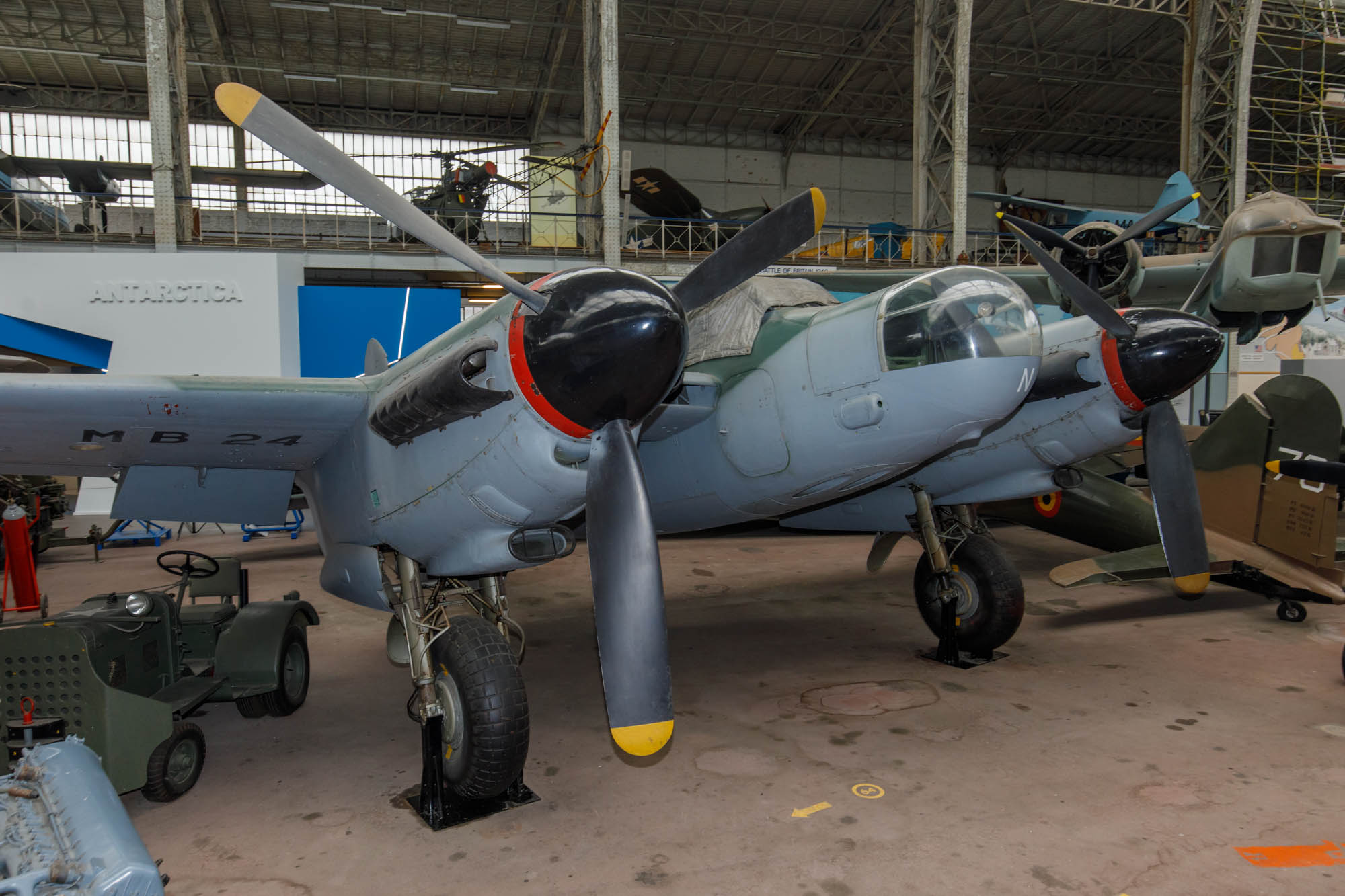 |
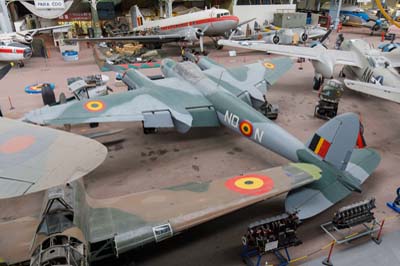 |
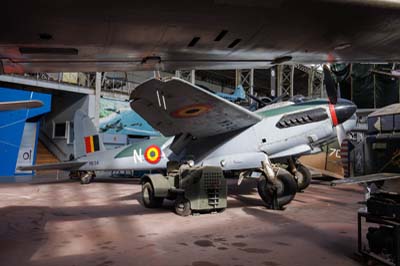 |
de Havilland DH-98 Mosquito NF.30 (MB24 'ND-N' of Belgian Air Force previously RK952). The Mosquito was designed to be fast, very fast. Constructed out of wood it was light and with conventional armament eliminated it was very light. It could carry 1,000 lb of bombs 1,500 miles at a speed of almost 400 mph. This was twice the speed of contemporary British bombers. Using the experience of building the DH.88 Comet Racer de Havilland conceived the aircraft in 1938, with the prototype day bomber taking to the air for the first time in November 1940. The Mosquito would eventually be used in a variety of roles, including; low-level tactical daytime bomber, high altitude night bomber, pathfinder, day and night fighter, trainer and for reconnaissance. Towards the end of its career it was used as a target tug. 7,781 were built the last was completed in 1950.
The Belgian Air Force received 39 Mosquito's from 1947. The ex RAF aircraft were either converted to target tugs (TT.3/6) or to night fighters (NF.30). Serials were MA-1 to MA-7 for the TT.3s, MC-1 to MC-3 for the TT.6s and MB-1 to MB-24 for the NF.30s. MB-24 which is exhibited, was the second of the final two aircraft delivered in September 1953, following modifications by Fairey Aviation at Ringway, Manchester. The surviving aircraft were all scrapped in 1956, with the exception of MB-24, which was struck off charge on October 17, 1956 at Beauvechain. It was transferred to the Museum in March 1957. Restoration started in 1979 with the final painting completed in 1984. |
Auster AOP.6 (OO-FDE c/n 2826 marked with its original military serial A-11). The Auster was based on the pre-war Taylorcraft D model and were manufactured by Auster Aircraft Limited. In military service they were used as a light spotter and observation aircraft. The RAF took delivery of 274 Auster AOP.6s 22 of which were transferred as new to Belgium (serials A-1 to A-22) in 1947 and 1948 for 369 Squadron. The Austers were eventually replaced by Piper Super Cubs during 1954 and 1955. The surviving Austers were then sold on the civil register. The Auster AOP.6 exhibited (A-11 ex VT990) moved to Belgian civil register in 1958, eventually ending up in a scrap yard by 1970. The museum has had at least ten Austers in it's charge since the 1970s and were to be used for possible exchanges. Five Austers are currently in storage. One Auster (A-16 registered OO-FDI) went to Kbely, Czech Republic in 1992.
|
| Piper L-18C Super Cub (OL-L87 ex 53-4749 c/n 18-3149). The Super Cub was developed from the L-4 Cub (Grasshopper), production of the PA-18 starting in 1949. 157 L-18Cs (OL-L01 to OL-L157) were delivered from 1952 for the Belgian Army Light Aviation (Licht Vliegwezen van het Landmacht/Aviation Légère de la Force Terrestre) to replace the Austers. Additionally six of the more powerful L-21Bs (LB01 to LB06) were acquired from Holland in 1975, operating as glider tugs with the Air Cadets. |
| Percival P.31C Proctor 4 (P-4). The Percival Proctor was a development of the pre-war Vega Gull. During World War One Proctors were used as communication and radio training aircraft. Six surplus RAF aircraft (P-1 to P-6) were delivered to 367 Squadron of the Belgian Air Force, between 1947 and 1948. They were withdrawn from service in 1954. P-4 which is on display (ex RAF NP171) crashed in May 1949. This example arrived at the museum in 1952. Another Proctor V (OO-ARM) was displayed in the museum in the 1970s. As photographed in 1982. |
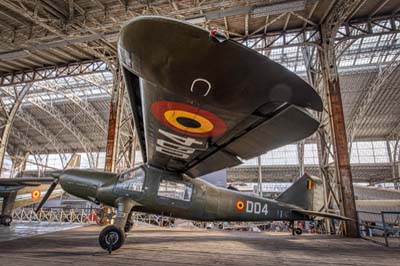 |
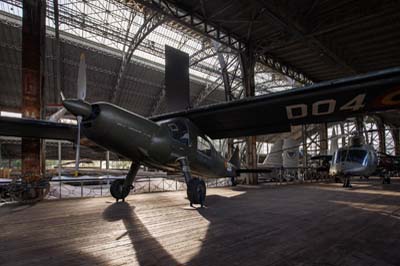 |
| Dornier Do-27J-1 (D04 OT-AMD). The first flight was made in 1954 and 626 were built up to 1965. Twelve Do-27s entered service with the Light Aviation branch of the Belgian Army in 1960. They were utilised as a six seat communications hack and as a platform for free fall parachute training. In March 1977 the final Dornier Do-27 flight was made. Following an accident at Brasschaat in March 1975, D04 was transferred to the museum in August 1977. As photographed in 1982. |
The SV-4 Stampe
Jean Stampe was a pilot in the Belgian Air Force during World War One. At the end of the War he joined forces with another World War One pilot to form Stampe & Vertongen Aircraft based at Antwerp, Deurne in 1923. Originally Tiger Moth dealers they decided in 1933 to design a comparable bi-plane training aircraft. Eight prototype demonstrator SV-4s were built in the 1930s leading up to World War Two. Following demonstrations to the Belgian and French Air Forces, they won orders for 30 and 300 respectively. 50 of the French order were built in Belgium before production was moved to Farmanns in France. Only ten were delivered before the start of the war halted all production.
At the end of the World War Two production of the SV-4 was resumed. Alfred Renard rejoined the team and Societe Stampe et Renard in Belgium produced the SV-4B and SNCA du Nord in France produced the SV-4C. To replace the Tiger Moth, the Belgian Air Force received 20 SV-4Bs (serials V-1 to V20) in 1948, followed by 45 SV-4Cs (serials V-21 to V-64) delivered between 1951 and 1955. The Stampe SV-4s were withdrawn by 1975, to be replaced by the SIAI-Marchetti SF.260MB. The museum has had at least eight SV-4B/Cs to be used as collateral for exchanges. SV-4B (V-62) was exchanged for a Danish Air Force Chipmunk in 1977. V-21 was exchanged for two Tipsy Trainers in 1989. |
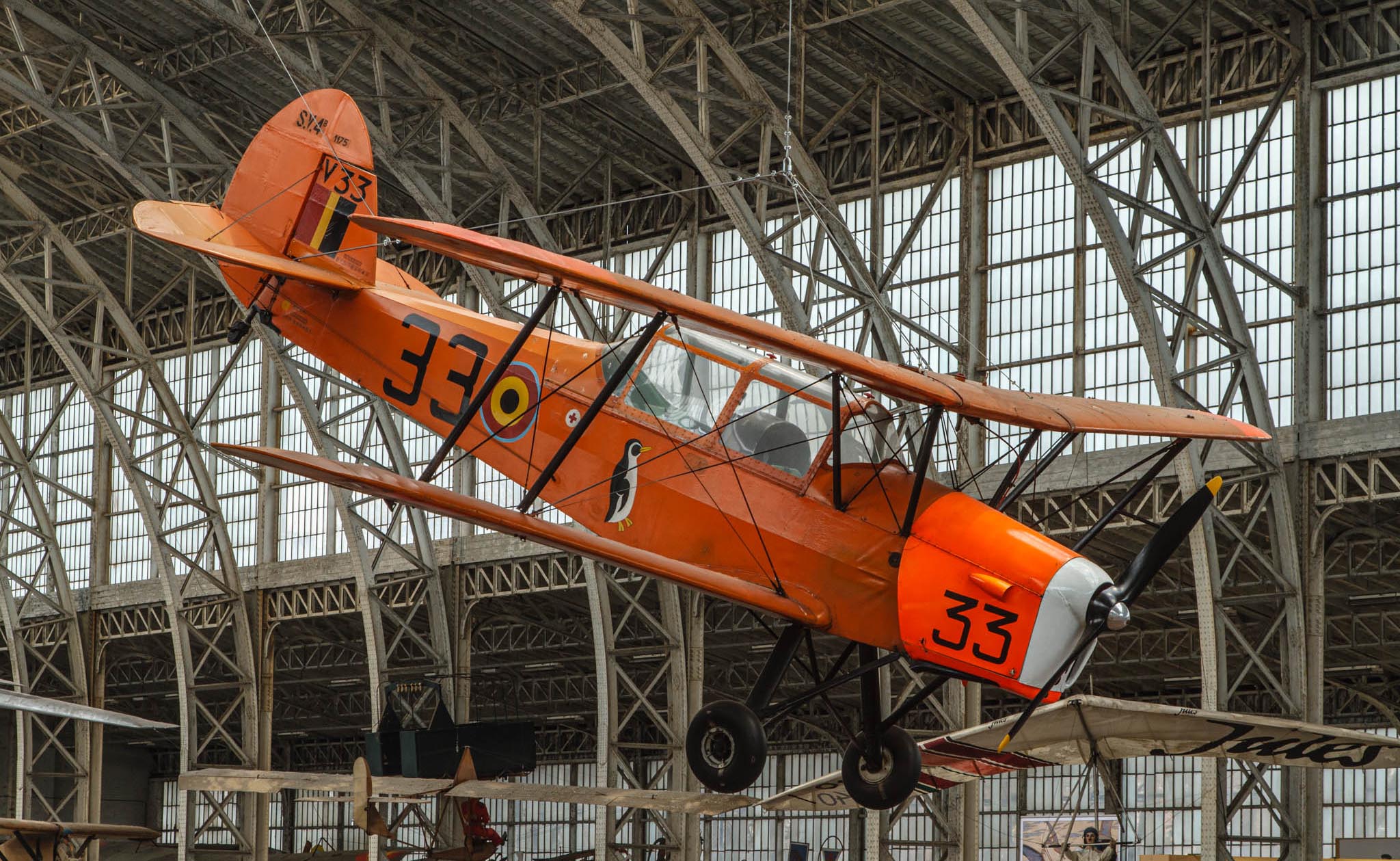 |
Stampe SV-4B (V-33) back at the museum after its prolonged display from the roof in the departure terminal at Brussels (Zaventem) airport since 1995.
In March 2008 it returned this time to be hung from the roof of the aircraft hall. |
| SV-4B Stampe (V-33 c/n 1175) ex Elementary Flying School (EVS) in its original orange colour scheme. V-33 first flew in 1952 and spent most of its working life with at Goetsenhoven and Nivelles in the flying training role. It later operated as a glider tug at Beauvechain. In August 1970 it was put in storage at Koksijde until it was struck off charge in May 1976. After a period as a travelling exhibit it was donated to the museum in 1980. |
Left to right:
SV-4B Stampe (V-56 c/n 1198) behind glass inside a 'sealed' side room. V-56 crash landed at Goetsenhoven in May 1957.
SV-4C Stampe (OO-CLH c/n 28 ex F-BFZC and 28 AdlA) Registered in Belgium in 1962. Although it originally served with the French Air Force (Armée de l'Aire) as No.28, before becoming F-BFZC, it has been painted in a spurious French Navy (Aeronavale) scheme as '102/5.S.25'. As photographed in 1982. |
| SV-4B Stampe (V-57 c/n 1199) all white, unmarked previously marked 'OO-ATD' to represent the famous aircraft which escaped to England at the start of the World War Two. It was retired in 1957 following an accident at Neerheylissem in May 1956, becoming the gate guard at Evere before being handed over to the Museum in 1964. |
Left to right:
SV-4B Stampe (V-64 c/n 1206) ex Belgian Air Force Elementary Flying School (Elementaire Vlieg School or EVS) in yellow-black "Les Manchots" (French for Penguins) aerobatic team colours. It was no longer on display by December 2009, moved on loan to the Beauvechain Historical centre, Beauvechain. As photographed in 1982.
SV-4B Stampe (V-28 c/n 1170) ex Elementary Flying School (EVS) in white-black-red "Les Manchots" colours and modified to a single seat. It was retired in 1970 and went into storage at Koksijde. (Stampe V-56 c/n 1198 is in a mock workshop within the Museum, minus it's upper wing which was part of the exchange deal for two Tipsy Nippers). Put on loan to the Stampe Vertongen Museum, Antwerp-Deurne. As photographed in 1982. |
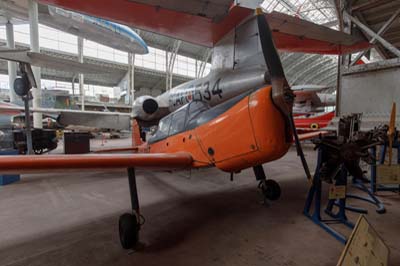 |
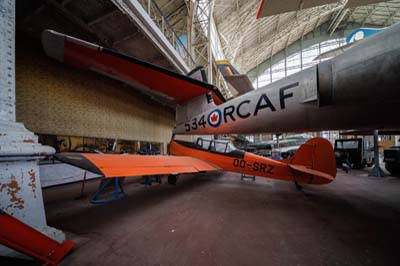 |
Left to right:
Stampe SV-4D (OO-SRS c/n 1208) Registered in March 1967 to Stampe and Renard SA at Gosselies and became Jean Renard's personal aircraft. It was donated to the museum in 1978. As photographed in 1982.
Stampe-Renard SR-7B Monitor (OO-SRZ c/n 1003) Registered to Stampe and Renard SA in April 1954, its C of A expired in 1978. Renard was eventually absorbed into Avions Fairey SA. The SR-7 was designed to replace the SV-4 in the Belgian Air Force, but lost out to the SIAI-Marchetti SF.260. As photographed in 1982. |
